Lecture 13-16 Ray Tracing¶
Why Ray Tracing¶
- 光栅化不能得到很好的全局光照效果
- 软阴影
- 光线弹射超过一次(间接光照)
- 光栅化是一个快速的近似,但是质量较低
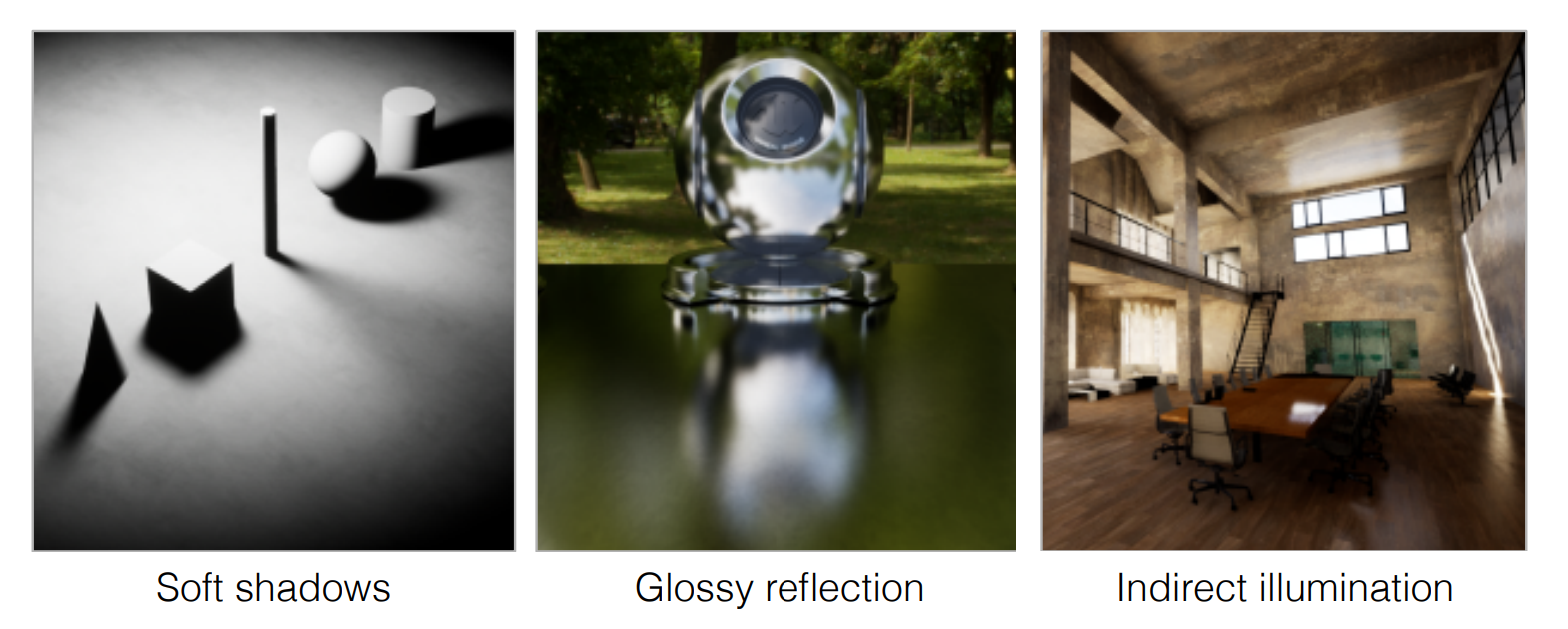
- 光线追踪是准确的,但是较慢
- Rasterization: real-time, ray tracing: offline
- 生成一帧需要一万CPU小时
Basic Ray-Tracing Algorithm¶
- 图形学上的光线定义
- 光线是沿直线传播的
- 两个或多个光线不会发生碰撞
- 光线一定会从光源出发到达我们的眼镜
- light reciprocity 光路的可逆性
Pinhole Camera Model¶
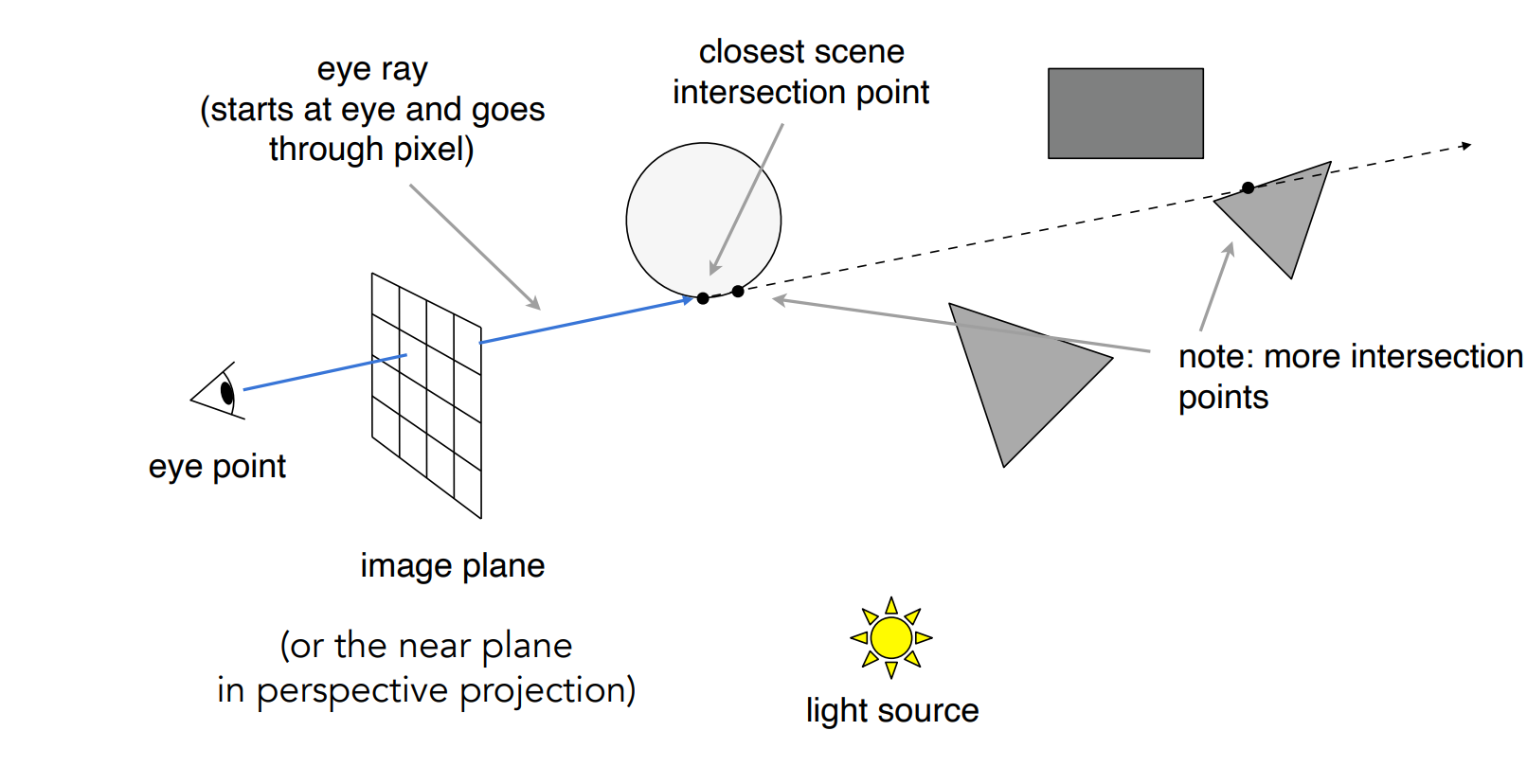
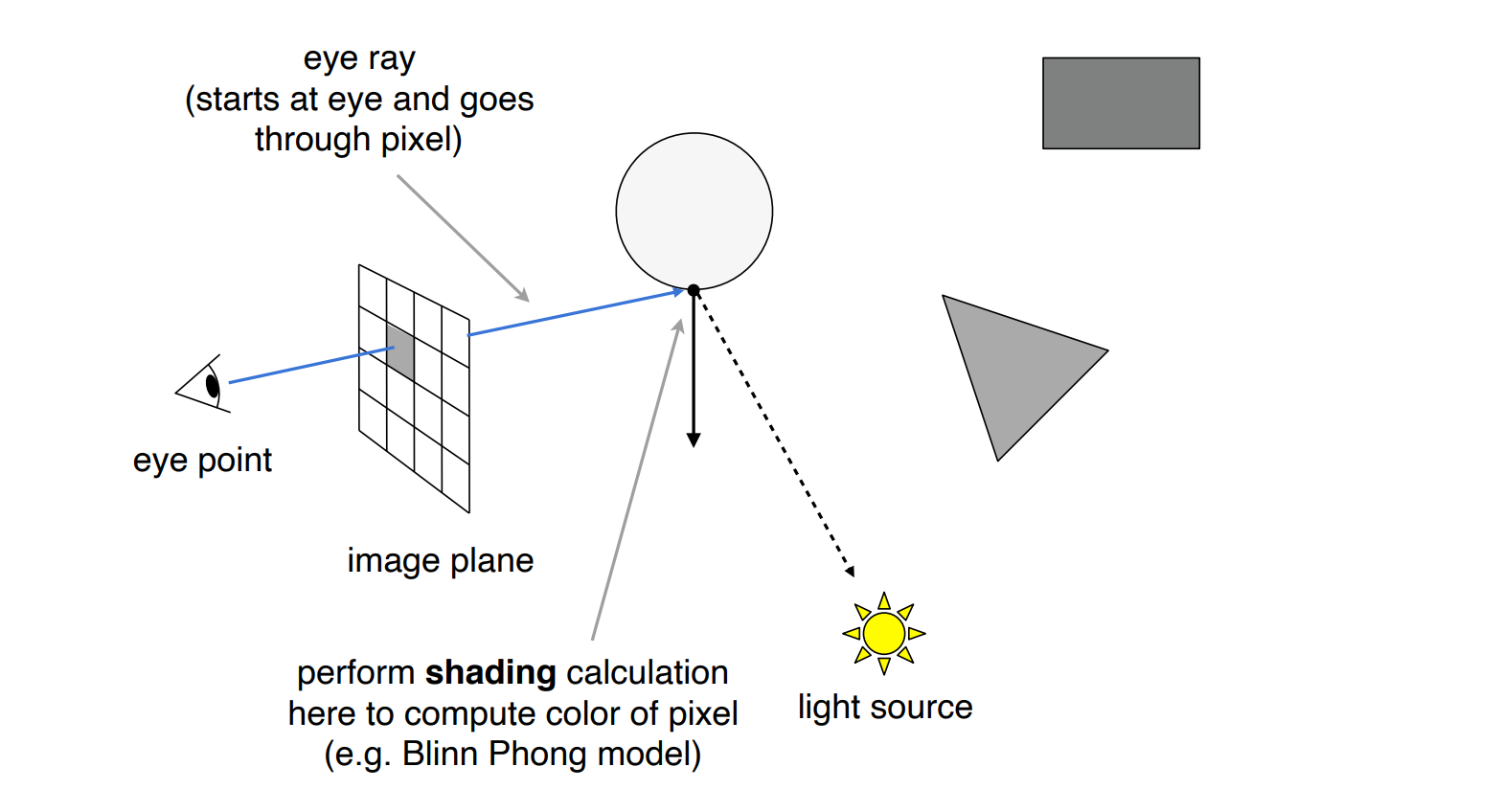
- 对于每一个像素,从眼睛投射出一个光线(eye ray)
- 和场景相交,求最近的交点
- 和光源连线判断是否对光源可见
- 计算着色,写回像素的值
以上算法还是只考虑了光线只弹射一次的情况
Recursive (Whitted-Style) Ray Tracing¶
- 在任意一个点可以继续传播光线(反射和折射)
- 所有点的着色都会被加到像素中(需要计算能量损失)
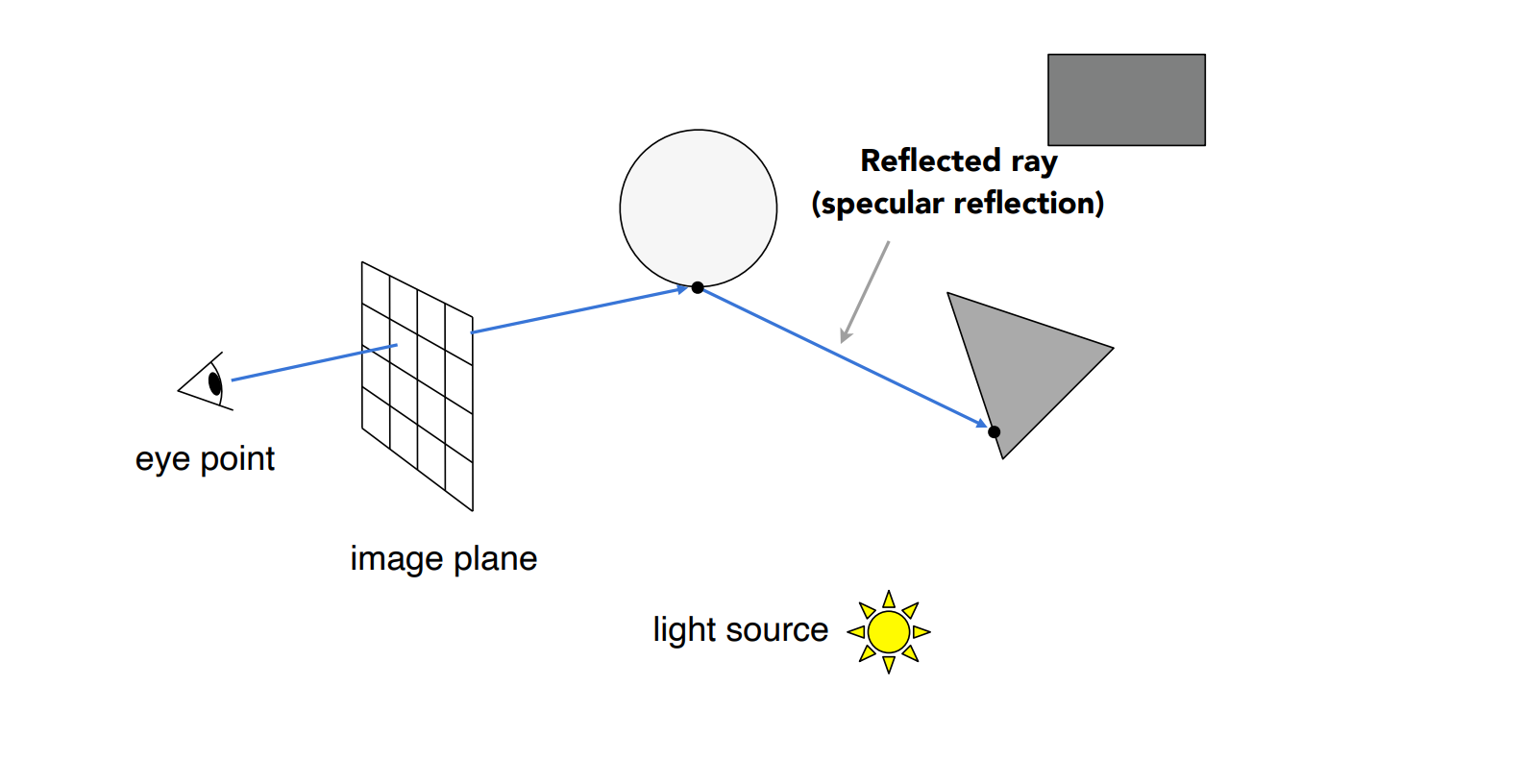
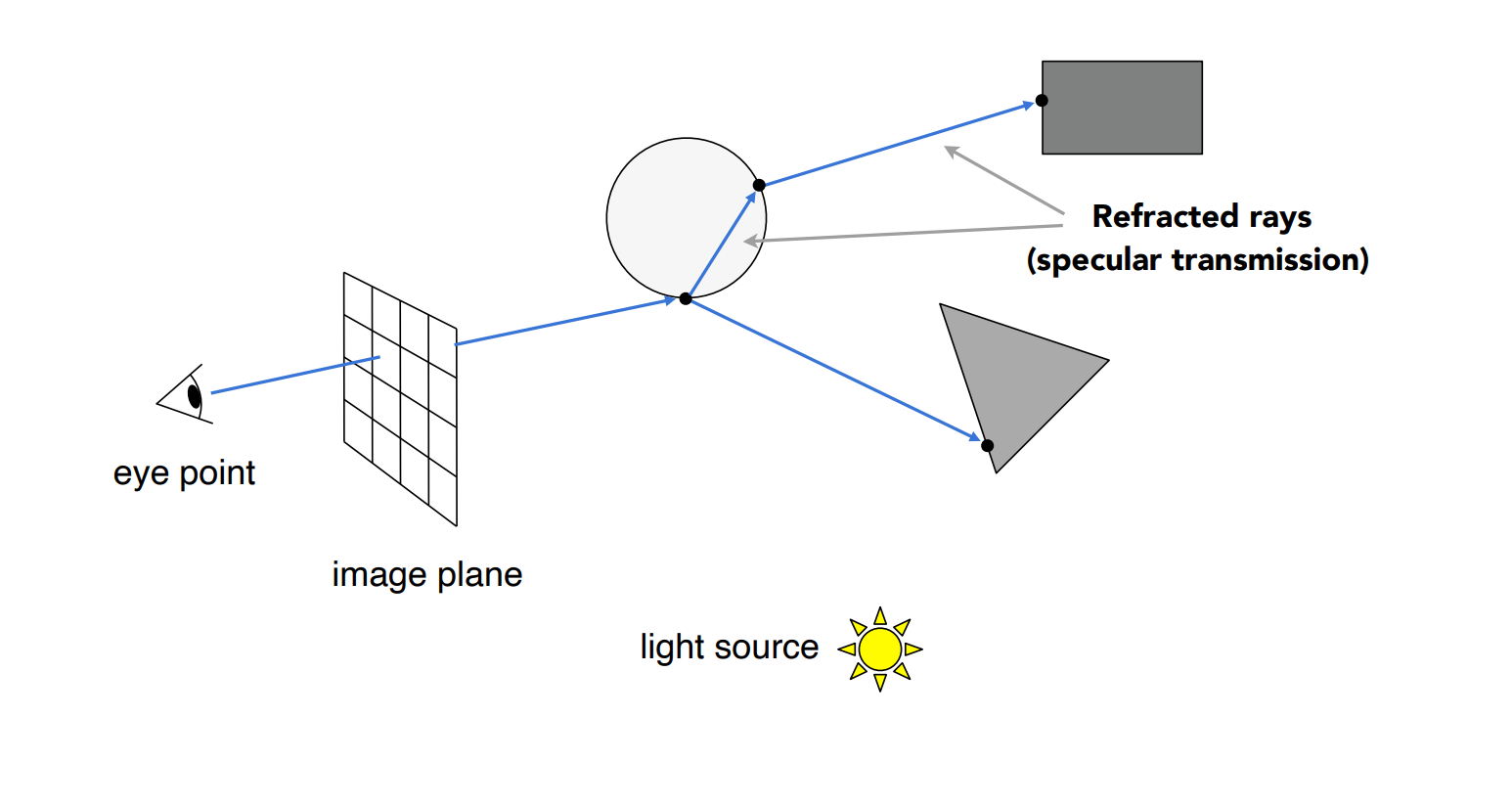
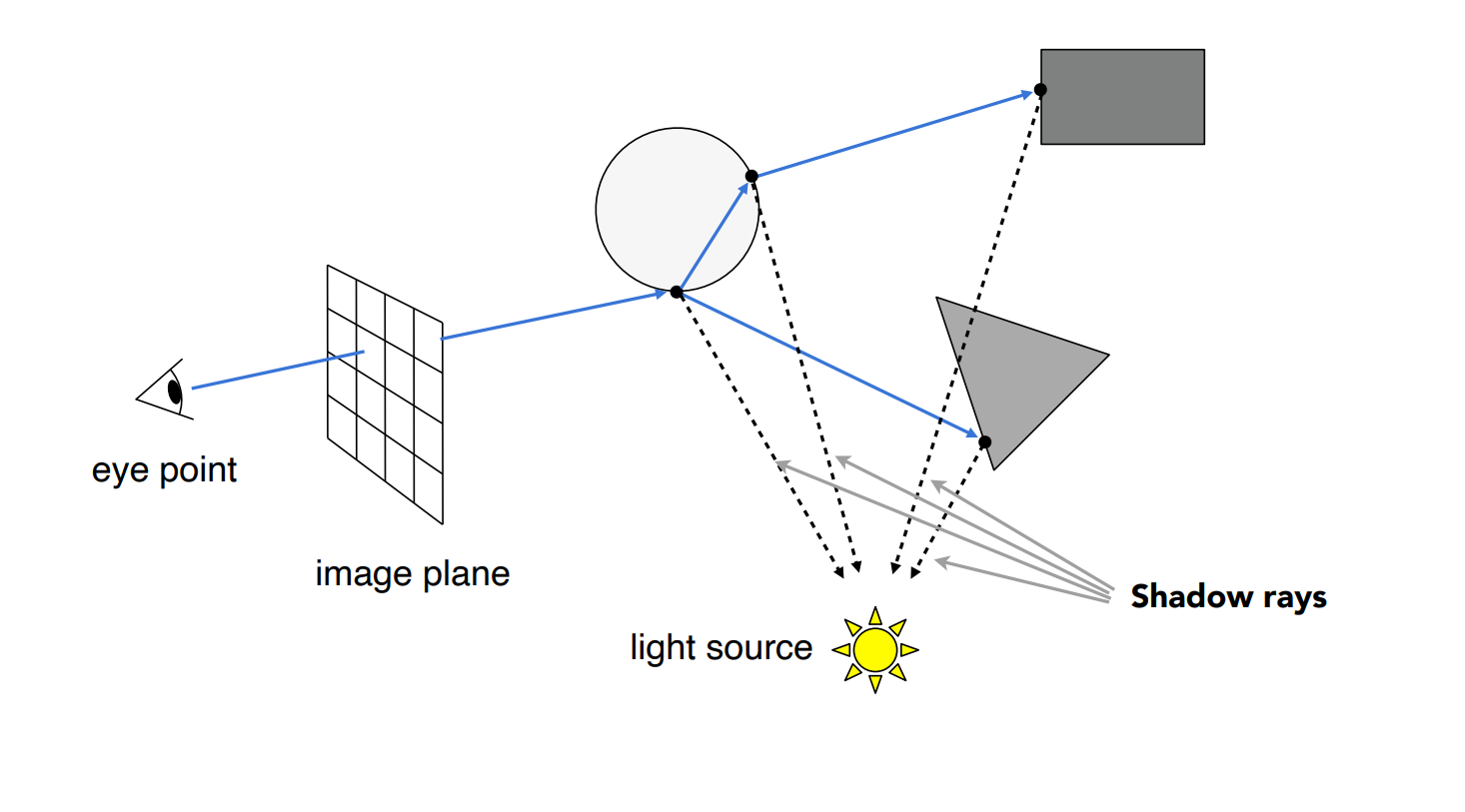
- 对于从眼睛出发的光线定义为 Primary Ray
- 由 Primary Ray 折射和反射的光线可以称作 Secondary Ray
- 判断可见性的光路被称作 Shadow Ray
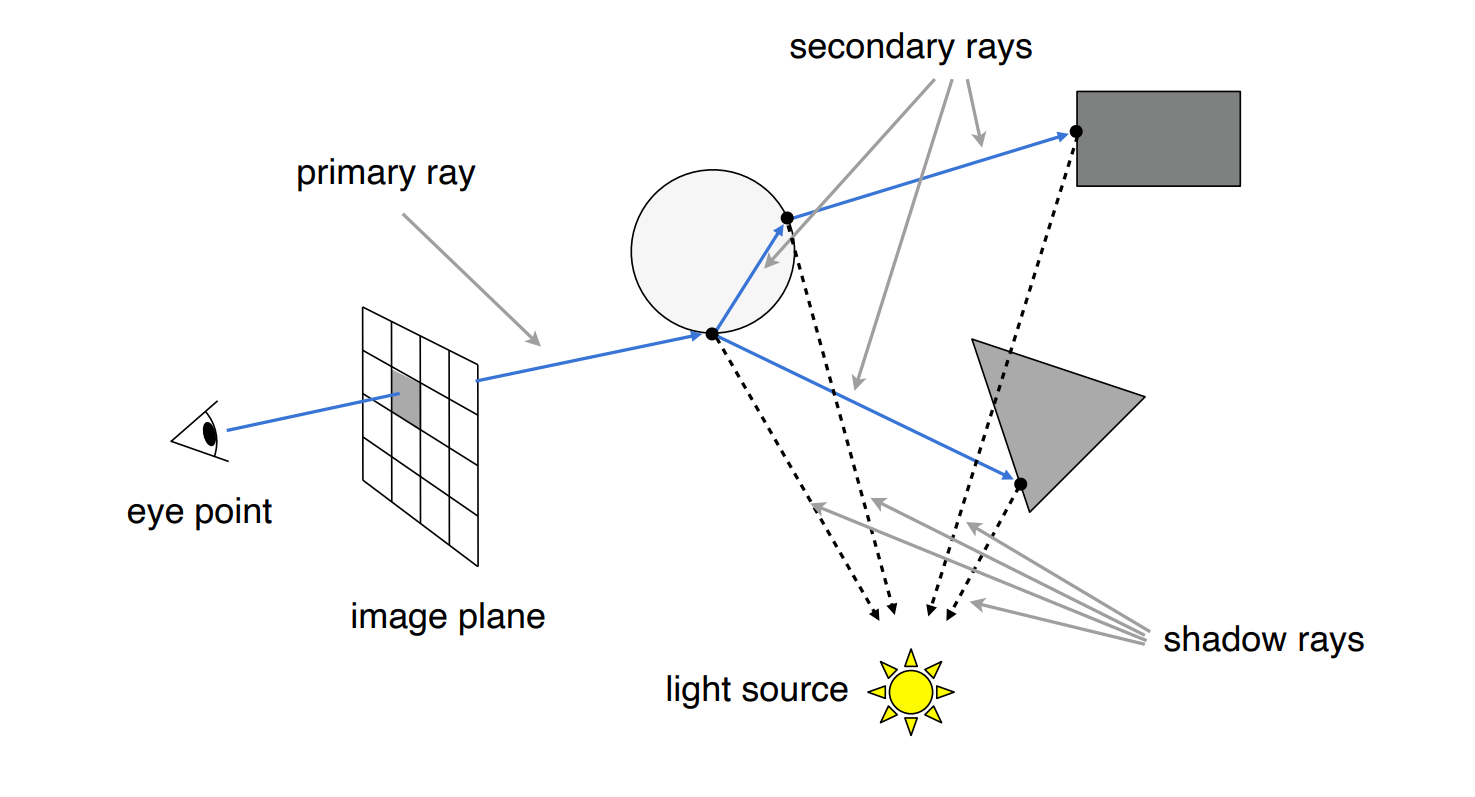
Ray-Surface Intersection¶
Ray Equation¶
- 光线被定义为有一个起点和方向的向量
- Equation: \(\mathbf{r}(t)=\mathbf{o}+t \mathbf{d}, 0 \leq t<\infty\)

Ray Intersection With Sphere¶
- Ray: \(\mathbf{r}(t)=\mathbf{o}+t \mathbf{d}, 0 \leq t<\infty\)
- Sphere: \(\mathbf{p}:(\mathbf{p}-\mathbf{c})^2-R^2=0\)
由于点需要满足两个方程,所以
展开后也就有,
注意,对于解出后的结果 \(t\),需要满足 \(t\ge 0\)
Ray Intersection With Implicit Surface¶
- Ray: \(\mathbf{r}(t)=\mathbf{o}+t \mathbf{d}, 0 \leq t<\infty\)
对于任意的隐式表面,有
- General implicit surface: \(\mathbf{p}: f(\mathbf{p})=0\)
- Substitute ray equation: \(f(\mathbf{o}+t \mathbf{d})=0\)
解出 Substitute ray equation 即可
注意,解出的结果需要是实数并且为非负数
Ray Intersection With Triangle Mesh¶
Convert It to Ray Intersection With Plane¶
-
Applications
- Rendering: visibility, shadows, lighting
- Geometry: inside/outside test (计算是否一个点是否在形状内部或者是外部,封闭物体)
- 在形状上取一个点找一个光线求交点,如果是奇数个交点,那么点就一定在物体内,否则在物体外
-
Compute
- Simple idea: just intersect ray with each triangle [Simple, but slow (acceleration?) ]
- Acceleration: 将光线和三角形求交转化为光线和平面求交,然后再判定交点是否在三角形内
Plane Equation¶
- Plane is defined by normal vector and a point on plane

Ray Intersection With Plane¶
-
Ray equation: \(\mathbf{r}(t)=\mathbf{o}+t \mathbf{d}, 0 \leq t<\infty\)
-
Plane equation: \(\mathbf{p}:\left(\mathbf{p}-\mathbf{p}^{\prime}\right) \cdot \mathbf{N}=0\)
-
Solve for intersection
- Check: \(0 \leq t<\infty\),判断这个点是否在三角形内
Möller Trumbore Algorithm¶
A faster approach, giving barycentric coordinate directly (以另外一个形式描述平面)
- 联立光线和重心坐标
- 使用克莱姆法则解这个线性方程组,解出 \(b_1,b_2,t\)
- 如果 \(1-b_1-b_2, b_1, b_2\) 都是非负的,那么点在三角形内
Accelerating Ray-Surface Intersection¶
- Simple ray-scene intersection
- Exhaustively test ray-intersection with every triangle
- Find the closest hit (i.e. minimum t)
- Problem
- Naive algorithm = #pixels ⨉ # triangles (⨉ #bounces)
- Slow!!!
Bounding Volumes¶
- Quick way to avoid intersections: bound complex object with a simple volume
- Object is fully contained in the volume
- If it doesn’t hit the volume, it doesn’t hit the object
- So test BVol first, then test object if it hits (如果一个光线连包围盒都碰不到,就也不可能碰到里面的物体)
- Understanding: box is the intersection of 3 pairs of slabs (认为长方体是三组对面形成的交集)
- Specifically: We often use an Axis-Aligned Bounding Box (AABB) [轴对齐包围盒]
Ray Intersection with Axis-Aligned Box¶
- 考虑二维的情况(两组对面): Compute intersections with slabs and take intersection of \(t_{min}/t_{max}\) intervals
- 对得到的两组线段求交集即可
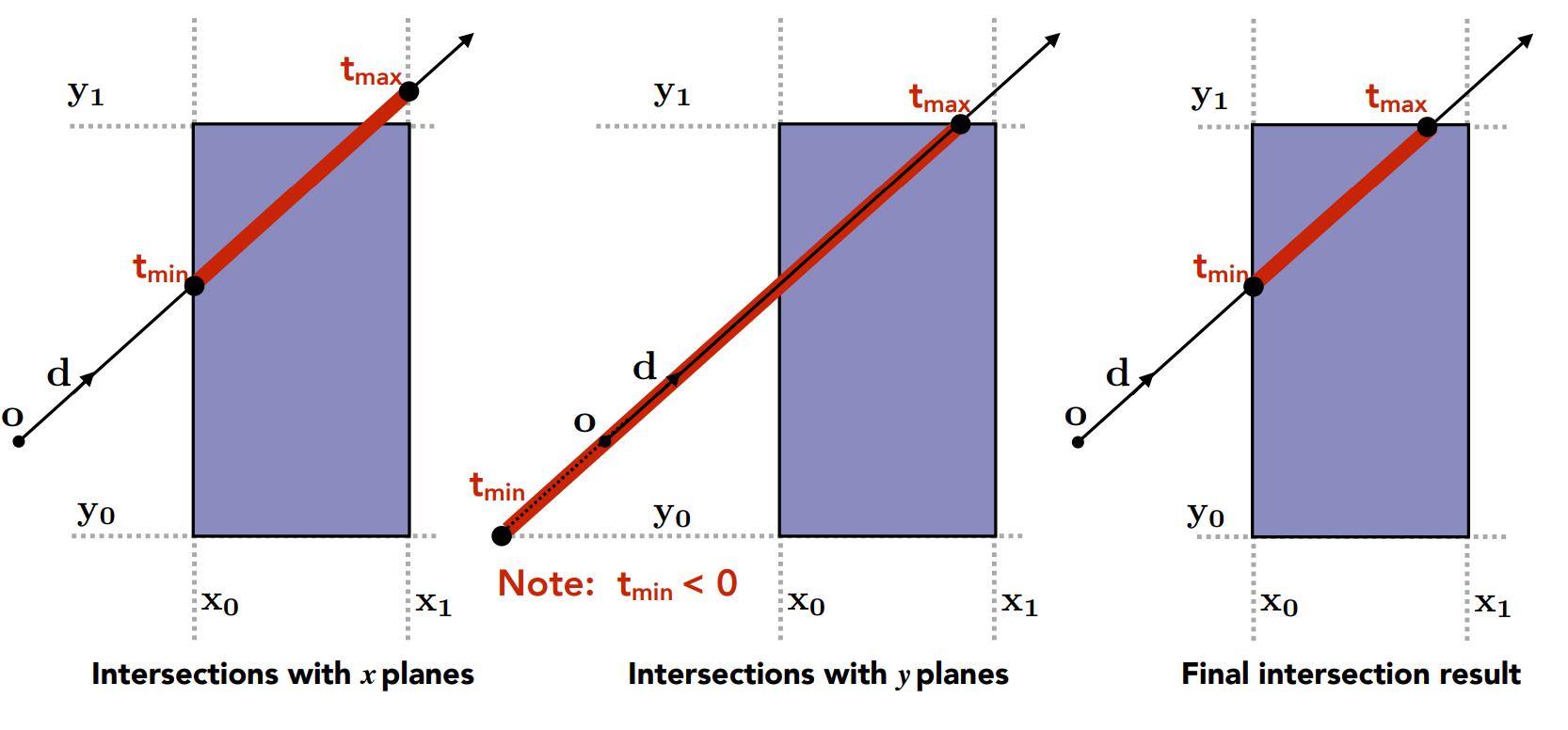
- Recall: a box (3D) = three pairs of infinitely large slabs
- Key ideas
- The ray enters the box only when it enters all pairs of slabs(如果三个对面都有光线进入,才能说光线进入了盒子)
- The ray exits the box as long as it exits any pair of slabs (只要光线离开任意一个对面,光线就算离开了这个盒子)
- For each pair, calculate the \(t_{min}\) and \(t_{max}\) (negative is fine)
- For the 3D box, \(t_{enter} = \max\{t_{min}\}, t_{exit} = \min\{t_{max}\}\)
- If \(t_{enter} < t_{exit}\), we know the ray stays a while in the box (so they must intersect!)
- physical correctness
- \(t_{exit}<0\), The box is "behind" the ray — no intersection
- \(t_{exit}\ge0, t_{enter}<0\), The ray’s origin is inside the box — certainly have intersection
In summary, Ray and AABB intersect iff
Why Axis-Aligned¶
- 在求交时计算方便
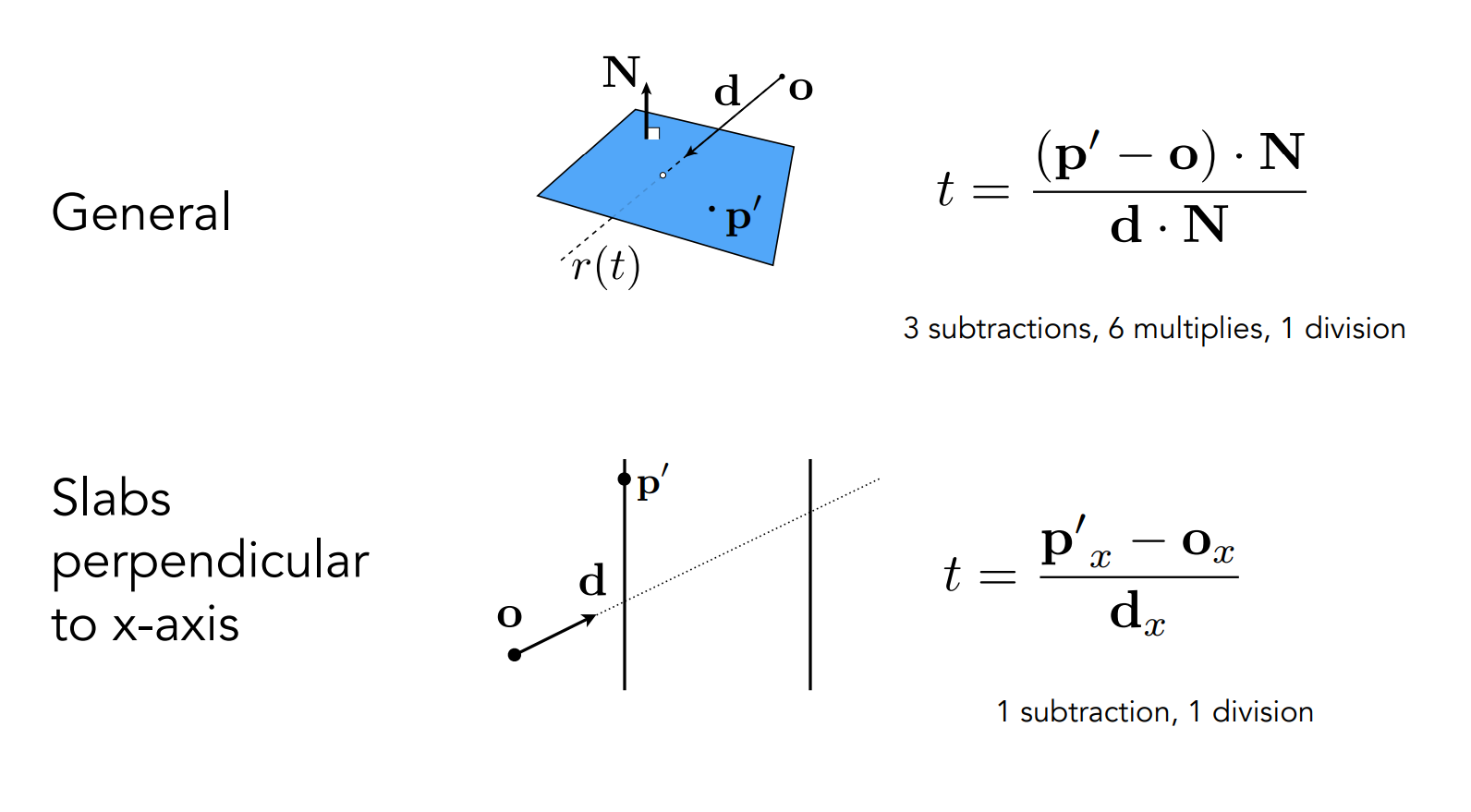
Using AABBs to accelerate ray tracing¶
Uniform Spatial Partitions (Grids)¶
- Precomputation
- Find bounding box
- Create grid
- Store each object in overlapping cells
- 只考虑物体的表面
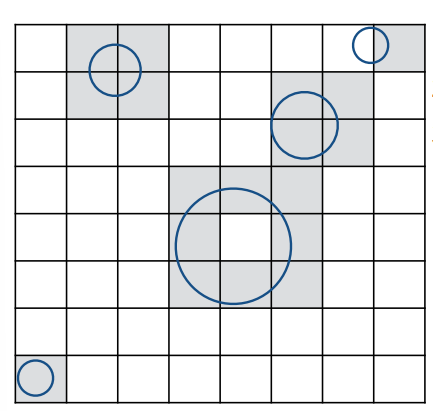
- Ray Tracing
- Step through grid in ray traversal order
- For each grid cell, Test intersection with all objects stored at that cell
- 让光线经过各个包围盒中的区块,让光线和盒子求交(假设光线和盒子求交的运行速度远大于和物体求交的运行速度)
- 如果发现和光线相交的盒子内有物体,再让物体和盒子求交,通过这样找到所有的交点
-
Grid Resolution?
- Heuristic
- #cells = C * #objs
- C = 27 in 3D
-
Pros & Cons
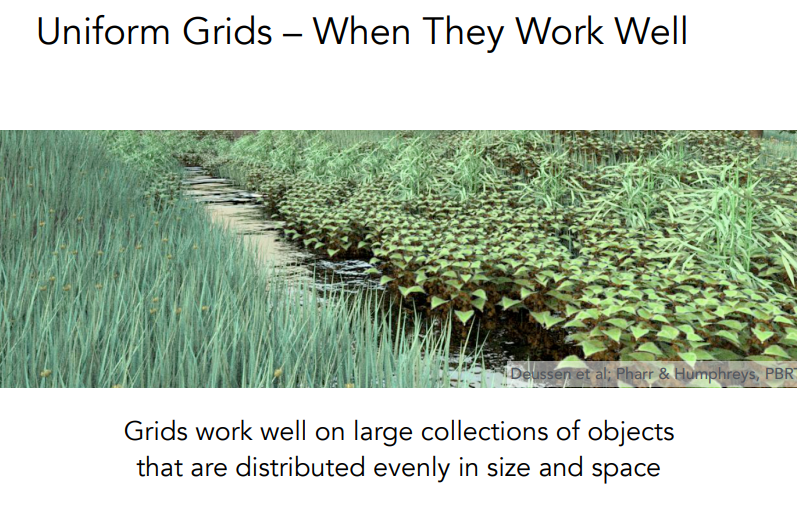
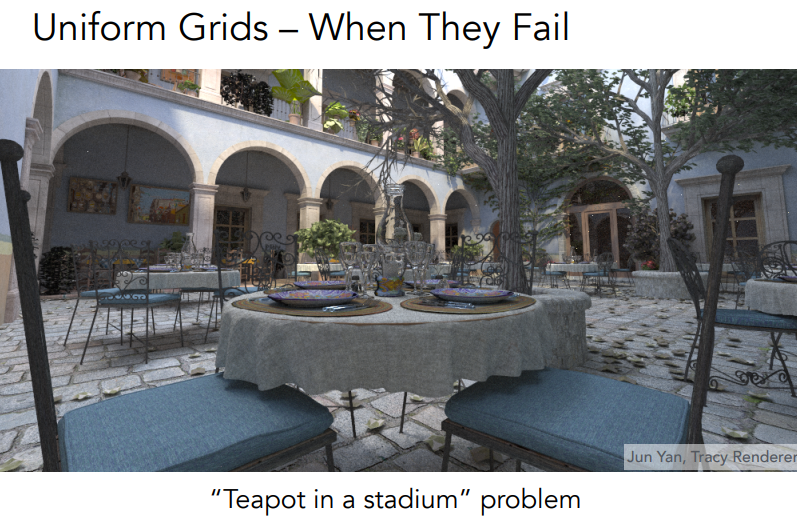
Spatial Partitions¶
-
基于 Grid 方法的优化,物体稀疏的地方不需要用很多格子
-
Examples
- Oct-Tree: 以下的八叉树是二维的情况,在二维空间中就是四叉的,把空间切成了不均匀的结构
- KD-Tree: KD-Tree 永远是找到一个轴把空间分成两个部分,和维数无关,把空间划分成了类似二叉树的结构,水平划分和数值划分是交替的以保证空间的划分是均匀的,计算简单
- BSP-Tree: 对空间的二分方法,每一次选择一个方向把节点的分开,和 KD-Tree 的区别是不是横平竖直的划分,会随着维度的升高计算变得复杂
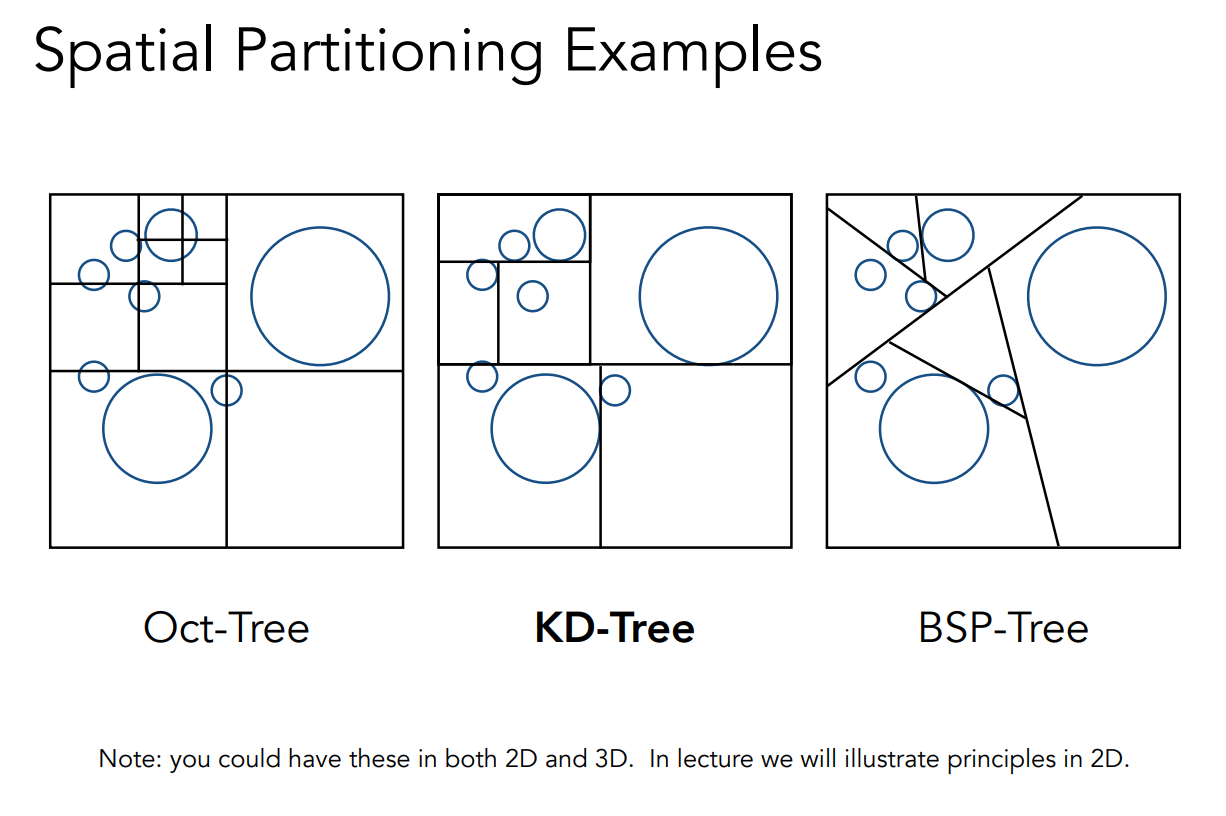
- KD-Tree Pre-Processing
- 此处只考虑每个格子划分了一次,实际中别的格子可能也需要划分
- 只在叶子节点存储三角形
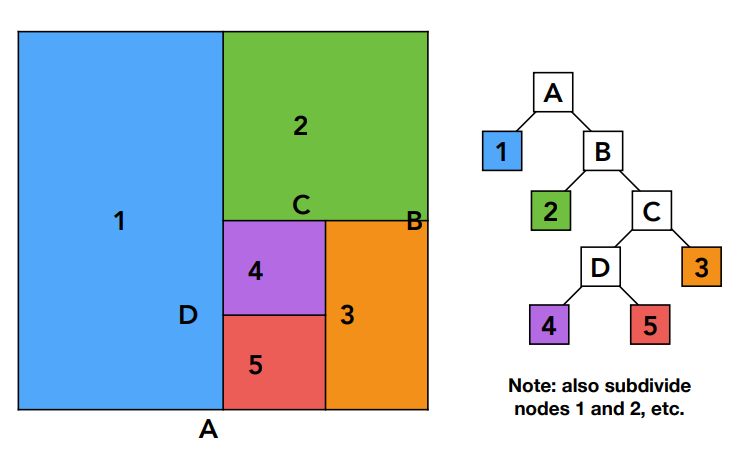
-
Data Structure for KD-Trees
- Internal nodes store
- split axis: x-, y-, or z-axis
- split position: coordinate of split plane along axis
- children: pointers to child nodes
- No objects are stored in internal nodes
- Leaf nodes store
- list of objects
-
Cons of KD-Tree
- 很难判定一个三角形是否和一个立方体有交集,算法很难实现
- 如果一个物体和多个盒子都有交集(出现在多个叶子节点中),KD-Tree 在这点上并不直观
Object Partitions & Bounding Volume Hierarchy (BVH)¶
- 划分物体而不是划分空间
- 对于下图,把三角形划分成蓝色和黄色三角形,并重新计算蓝色和黄色三角形的包围盒
- 终止条件是一堆里最多有 \(N\) 个三角形
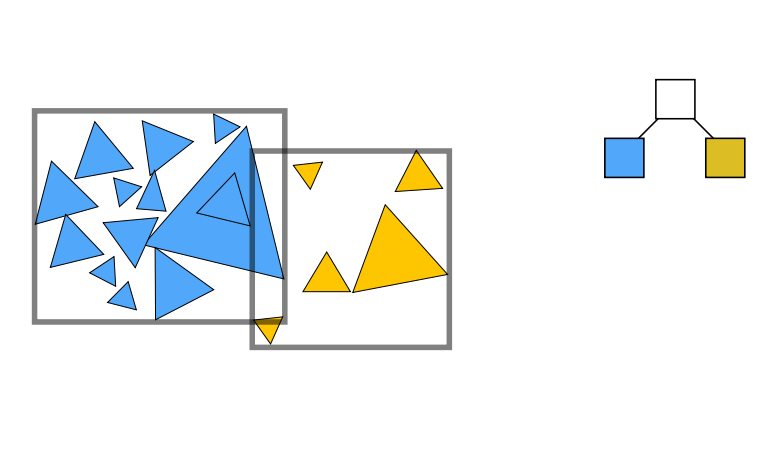
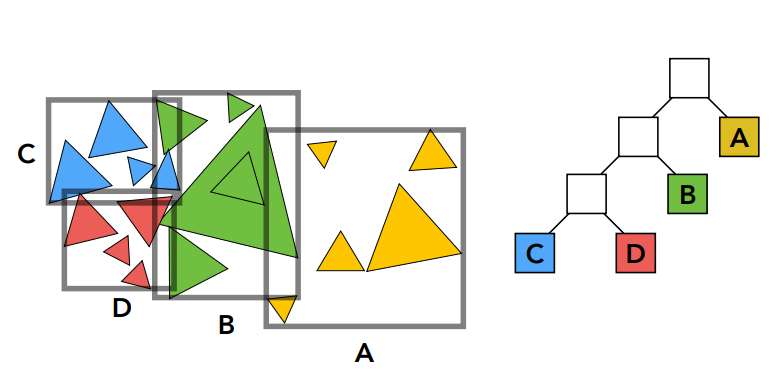
- Pros of BVH
- 节省了三角形和包围盒求交问题
- 保证了一个三角形只在一个盒子里
- Cons of BVH
- 不同的 Bounding Box 是有可能相交的
- 不能解决动态的物体,BVH 需要重新计算
- Summary
- Find bounding box
- Recursively split set of objects in two subsets
- Recompute the bounding box of the subsets
- Stop when necessary
- Store objects in each leaf node
-
Methods to subdivide a node
- Choose a dimension to split
- Heuristic #1: Always choose the longest axis in node
- 让最长的轴变短,让最终的划分是比较均匀的
- Heuristic #2: Split node at location of median object
- 取中间的物体指的是,如果有 \(n\) 个三角形,找的是 \(\frac{n}{2}\) 处的三角形,保证切分后的三角形数量差不多,以保证生成的树是平衡的,减少最终的搜索时间
- 给任意一列无序的数,找到它第 \(i\) 大的数,可以使用快速选择算法,在 \(O(n)\) 内解决
-
Termination criteria
- Heuristic: stop when node contains few elements (e.g. 5)
- Data Structure for BVHs
- Internal nodes store
- Bounding box
- Children: pointers to child nodes
- Leaf nodes store
- Bounding box
- List of objects
- Nodes represent subset of primitives in scene
- All objects in subtree
BVH Traversal¶
fun Intersect(Ray ray, BVH node) {
if (ray misses node.bbox) return;
if (node is a leaf node)
test intersection with all objs;
return closest intersection;
hit1 = Intersect(ray, node.child1);
hit2 = Intersect(ray, node.child2);
return the closer of hit1, hit2;
}
Basic Radiometry¶
- Chinese Name: 辐射度量学
Why Radiometry¶
- 在计算光强的时候,我们没有准确的物理定义
- 辐射度量学:定义了一系列方法和单位去描述光照
-
Accurately measure the spatial properties of light
- New terms: Radiant flux, intensity, irradiance, radiance
-
Perform lighting calculations in a physically correct manner
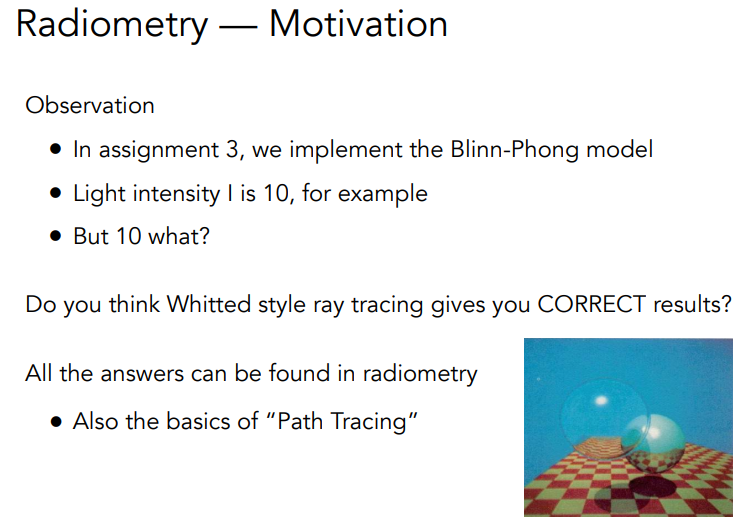
- Light Measurements
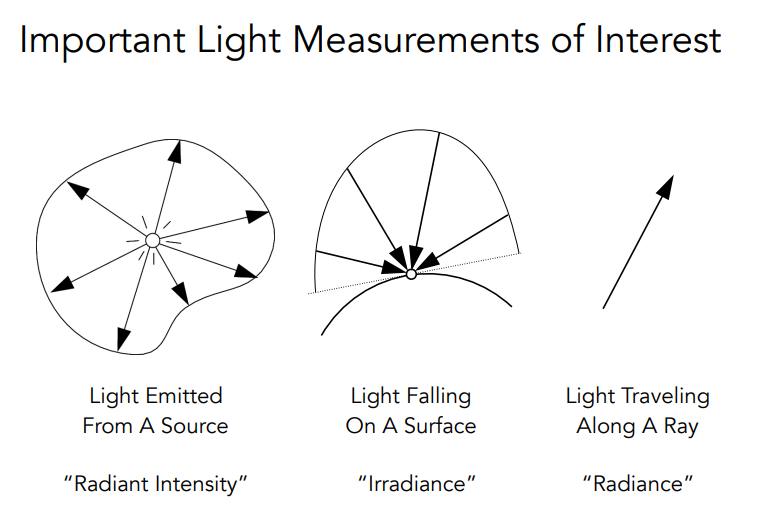
Radiant Energy and Flux (Power)¶
- Radiant Energy: 光源辐射出来的能量 (Barely used in CG)
-
Flux (Power): 光源辐射出的单位时间的能量,目的是分析和比较两个和多个能量(去除时间的影响)
-
lm = lumen (Flux 的单位,翻译是流明)
-
Flux 也可以理解为单位时间通过一个感光平面的光子数目
-
Radiant Intensity¶
-
Radiant Intensity: The radiant (luminous) intensity is the power per unit solid angle (立体角) emitted by a point light source.
-
可以理解为能量除以立体角
-
定义了光源在任何一个方向上的亮度
-
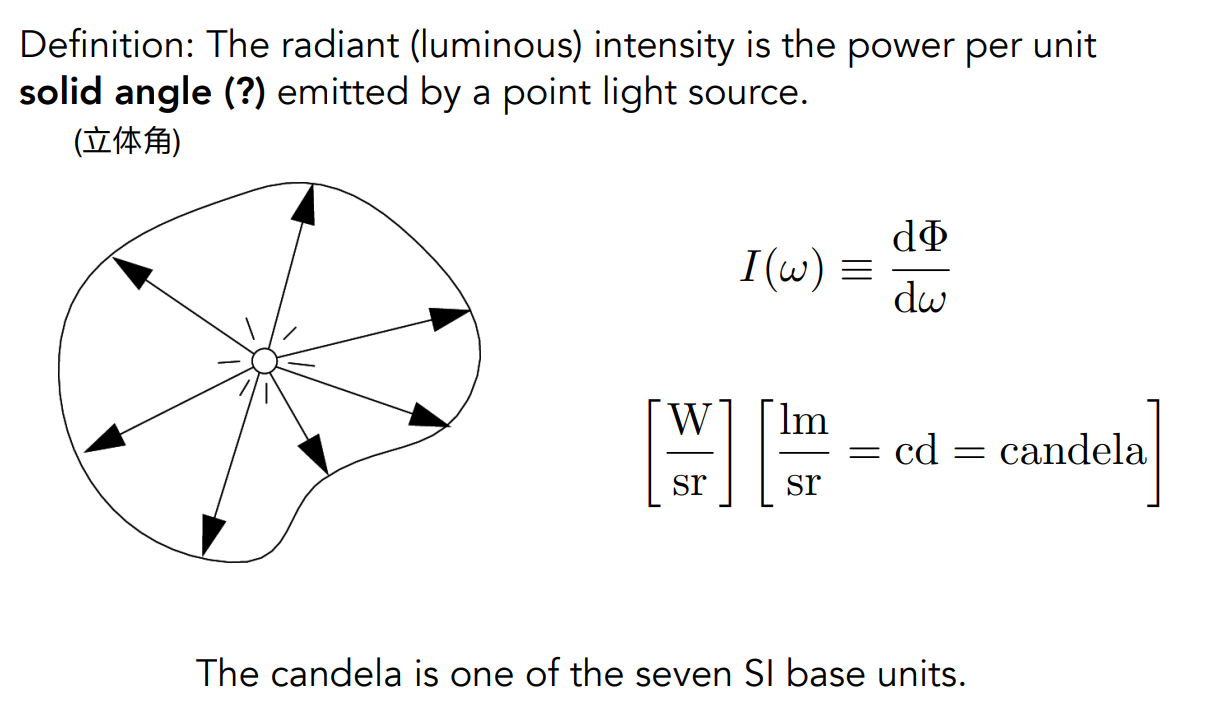
Angles and Solid Angles¶
-
Angle: ratio of subtended arc length on circle to radius
- \(\theta=\frac{l}{r}\)
- Circle has \(2 \pi\) radians
-
Solid angle: ratio of subtended area on sphere to radius squared
- 弧度制在三维空间中的延申,在三维空间中找一个球,从球出发形成某个大小的锥,锥会打到球面上,形成一个面积 \(A\),立体角是它除以半径的平方
- 把任何一个物体投影到单位球上,在单位球上框出的范围就是立体角
- 描述一个空间中角有多大
- \(\Omega=\frac{A}{r^2}\)
- Sphere has \(4 \pi\) steradians(立体角的单位)
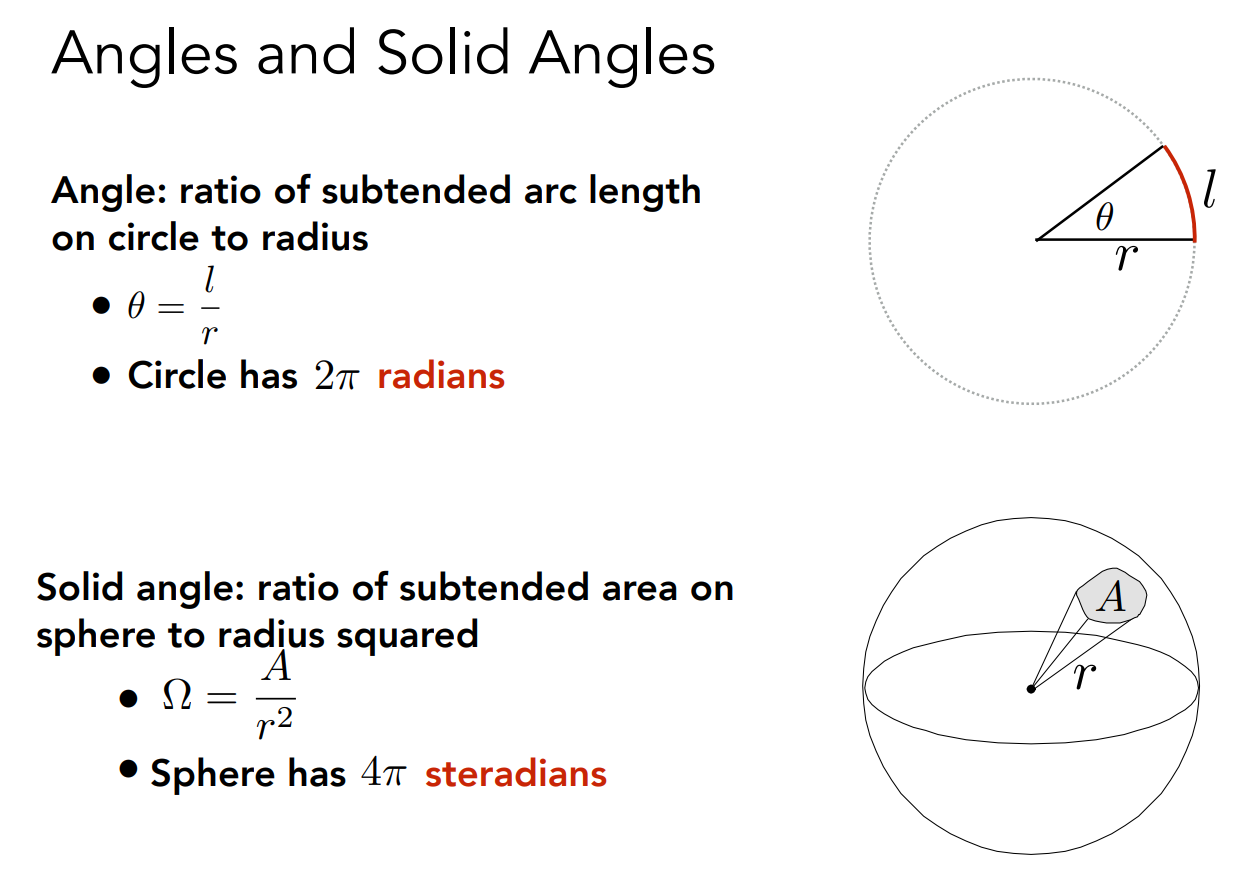
Differential Solid Angles¶
- Differential Solid Angles: 微分立体角
- 通常使用 \(\omega\) 来定义单位方向
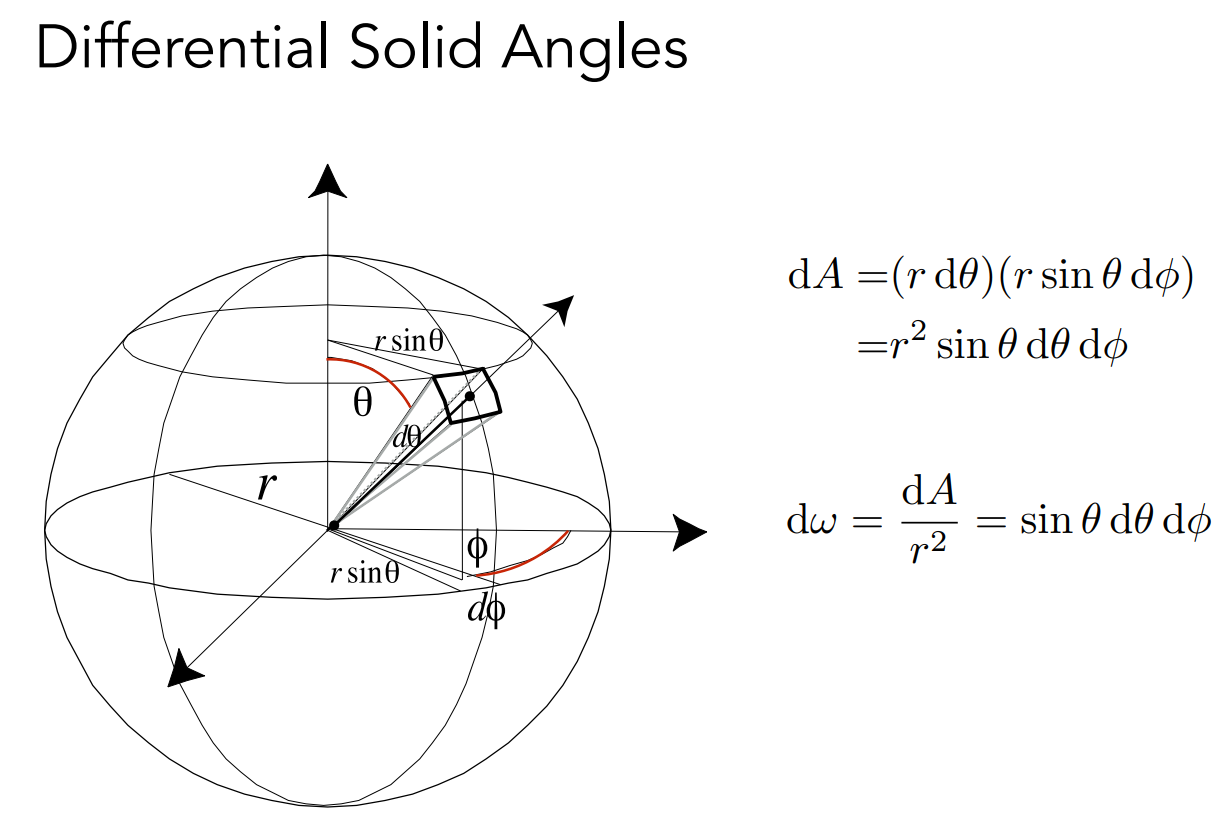
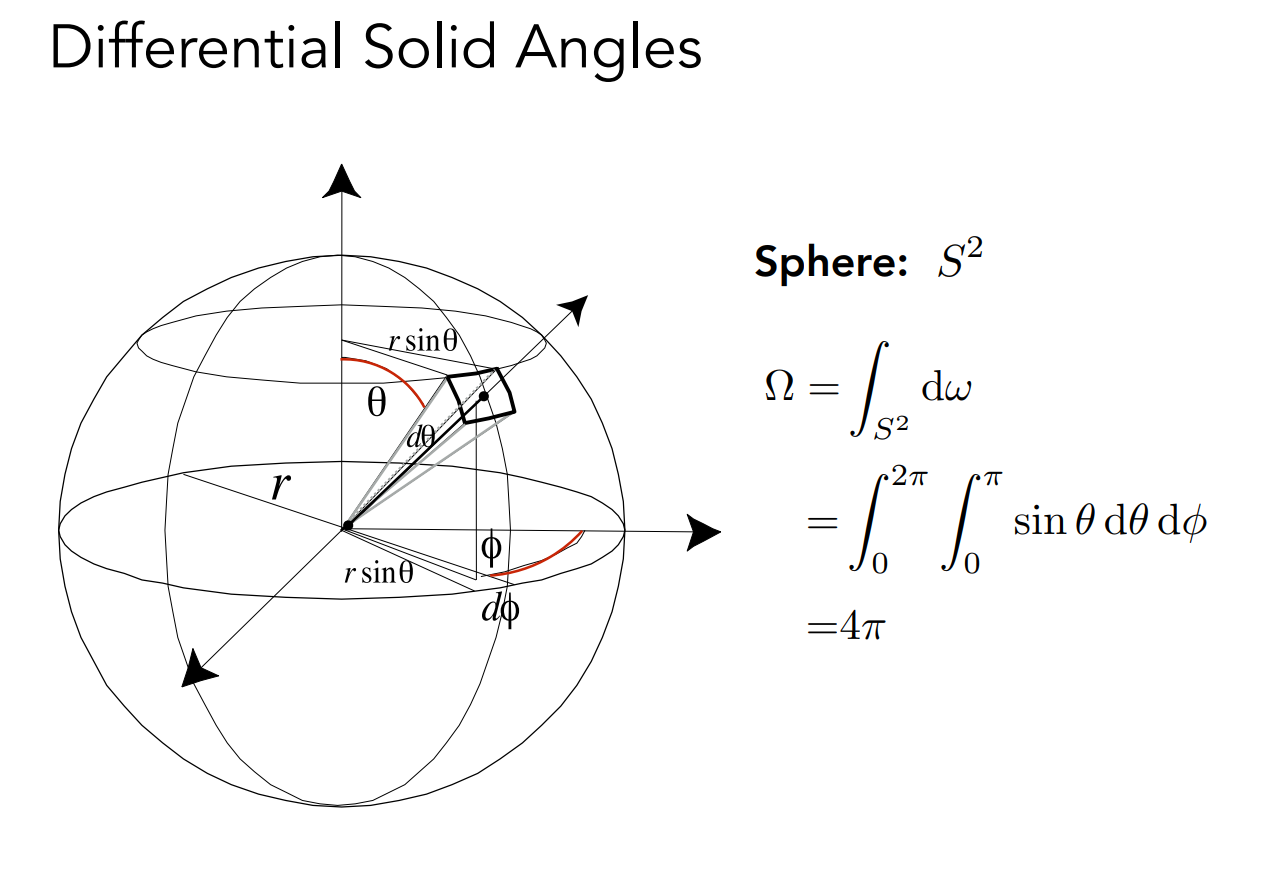
Isotropic Point Source¶
-
对于一个均匀点光源,它的 Radiant Intensity 的相关计算是
- 对于所有方向上的 Intensity 积分起来可以得到 Flux
\[ \begin{aligned} \Phi &=\int_{S^2} I \mathrm{~d} \omega \\ &=4 \pi I \end{aligned} \]- 对于任何一个方向上的 Intensity 有
\(\( I=\frac{\Phi}{4 \pi} \)\)
Irradiance¶
-
The irradiance is the power per unit area incident on a surface point.
-
Intensity: power per soild angle
-
注意,面需要和入射光线垂直
-
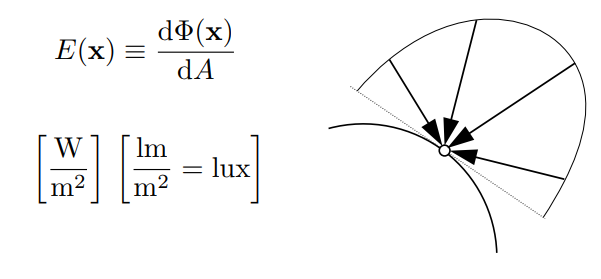
Radiance¶
Radiance is the fundamental field quantity that describes the distribution of light in an environment
- Radiance: The radiance (luminance) is the power emitted, reflected, transmitted or received by a surface, per unit solid angle, per projected unit area.
- 考虑某一个确定的微小面和一个方向
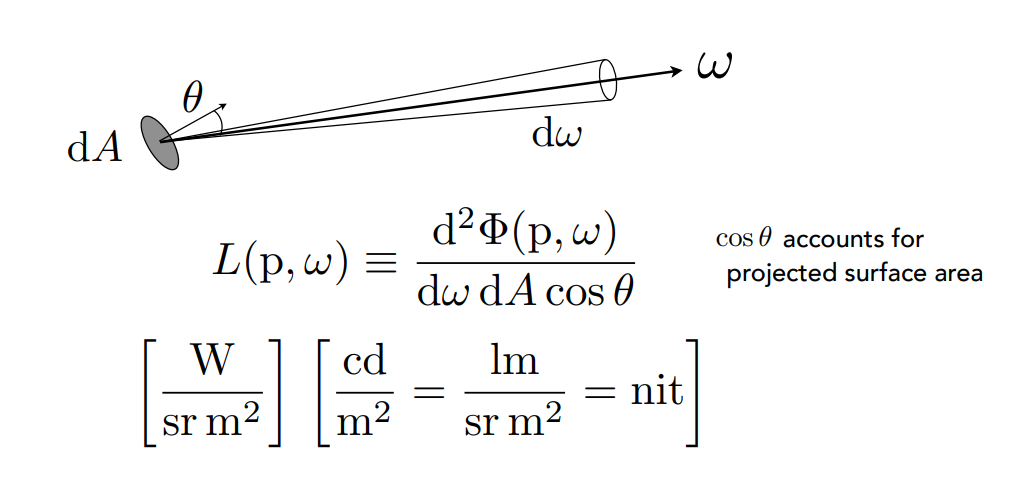
-
Recall
- Irradiance: power per projected unit area
- Intensity: power per solid angle
-
So
- Radiance: Irradiance per solid angle
- Radiance: Intensity per projected unit area
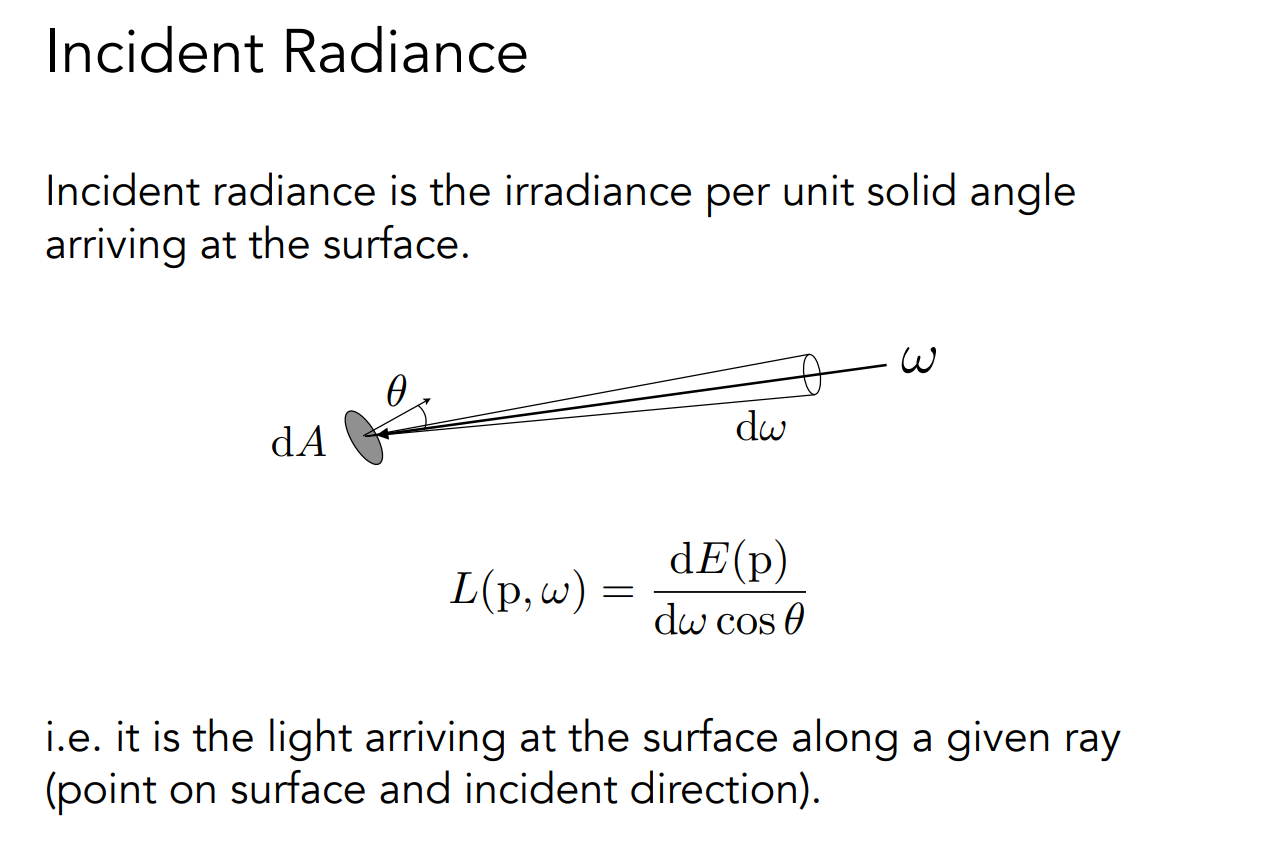
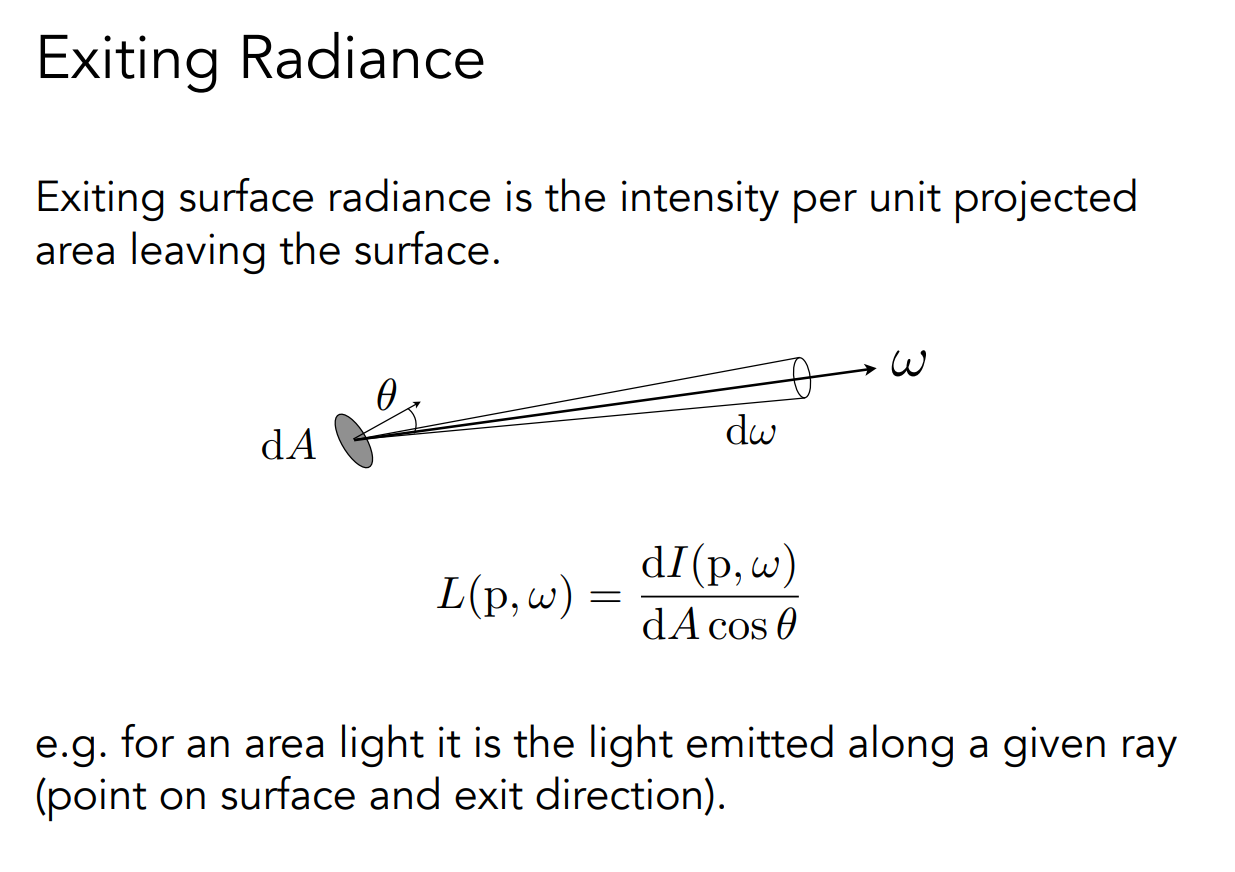
Irradiance vs. Radiance¶
-
Irradiance: total power received by area dA
- 某一个小区域内接收到的所以能量
-
Radiance: power received by area dA from “direction” dω
- 某一个小区域的某一个方向上接受到的能量
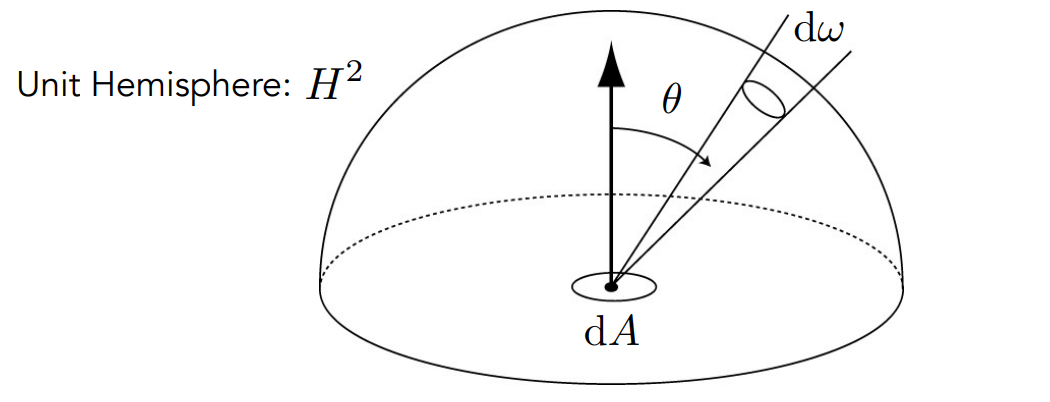
Bidirectional Reflectance Distribution Function (BRDF)¶
- 双向反射分布函数
- 告诉你不同反射方向上分布的能量情况
Reflection at a Point¶
Radiance from direction ωi turns into the power E that dA receives Then power E will become the radiance to any other direction ωo
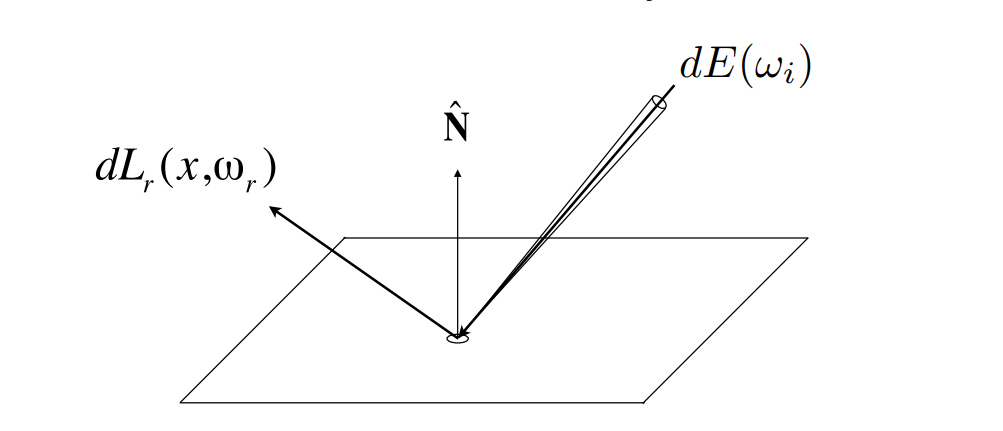
- Differential irradiance incoming: \(\quad d E\left(\omega_i\right)=L\left(\omega_i\right) \cos \theta_i d \omega_i\)
- Differential radiance exiting (due to \(d E\left(\omega_i\right)\) ): \(\quad d L_r\left(\omega_r\right)\)
BRDF¶
The Bidirectional Reflectance Distribution Function (BRDF) represents how much light is reflected into each outgoing direction \(\omega_r\) from each incoming direction
BRDF 描述了光线和物体是如何作用的
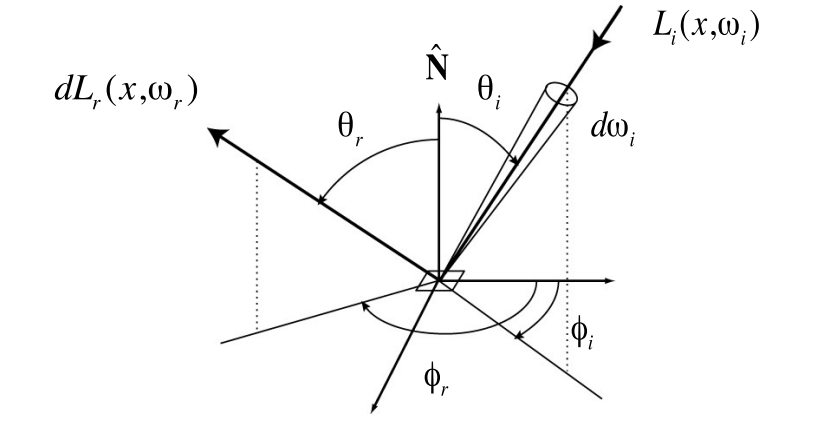
The Reflection Equation¶
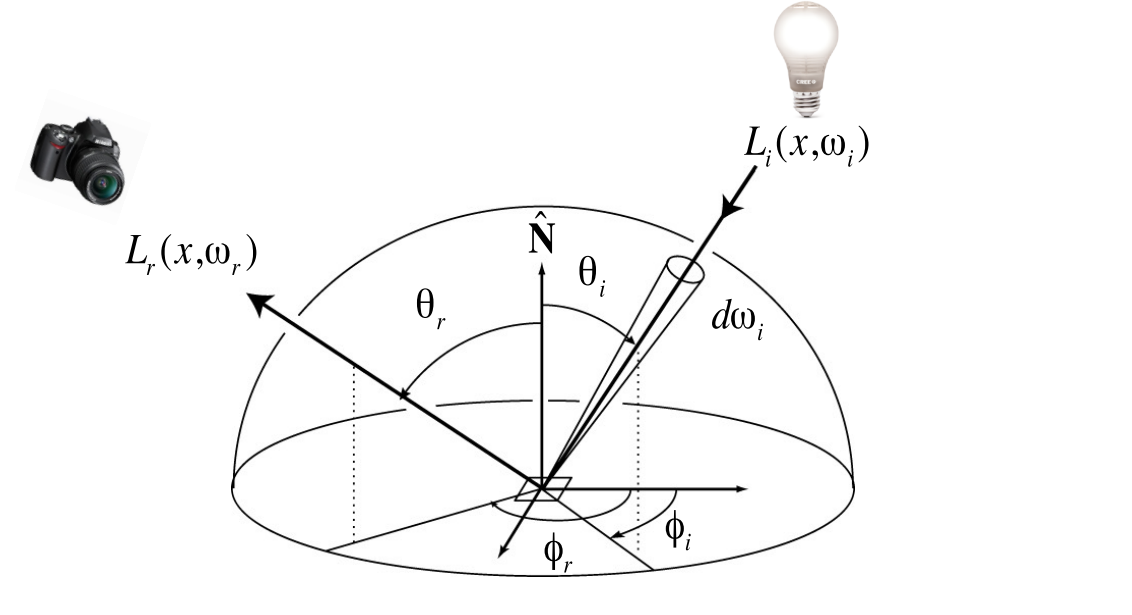
- Reflection Equation 描述了任何一个着色点在各种不同光照环境下对出射光线的贡献
Challenge: Recursive Equation¶
- 能够到达着色点的光线不止有光源,还有其他物体的反射出去的 Radiance
The Rendering Equation¶
Re-write the reflection equation:
by adding an Emission term to make it general(考虑物体会发光的情况),这样就得到了 Rendering Equation
Note: now, we assume that all directions are pointing outwards!
Understanding the rendering equation¶
Reflection Equation¶
- 当有一个点光源时
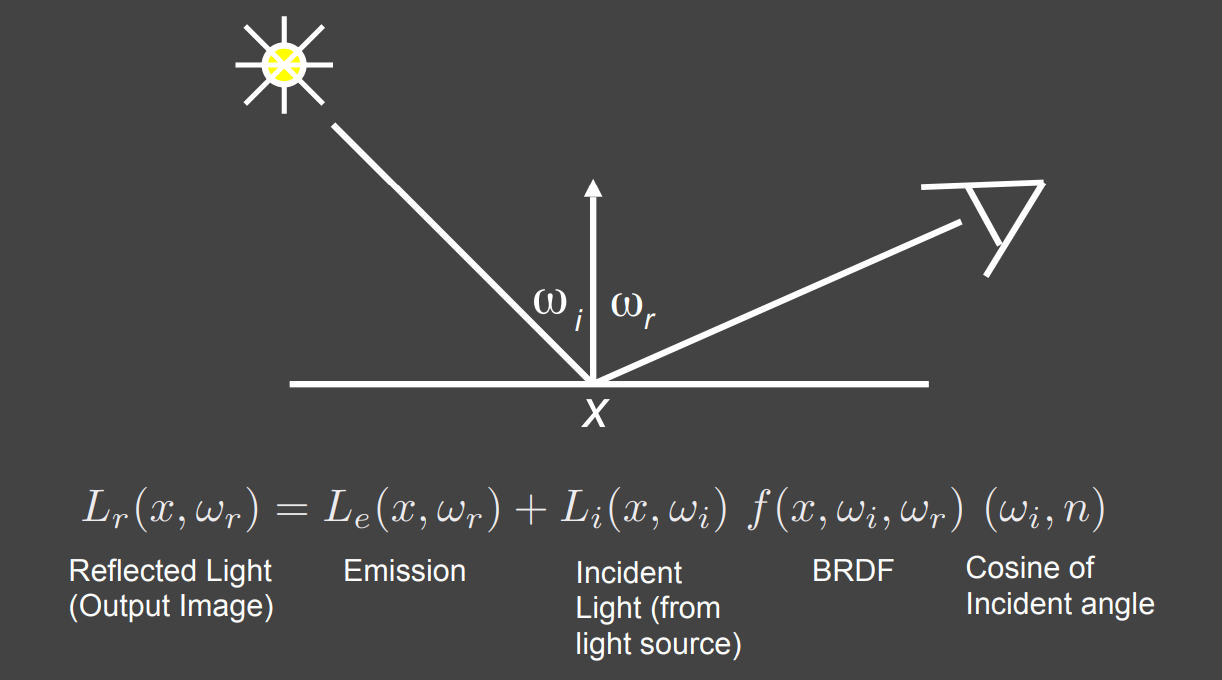
- 当有很多点光源时
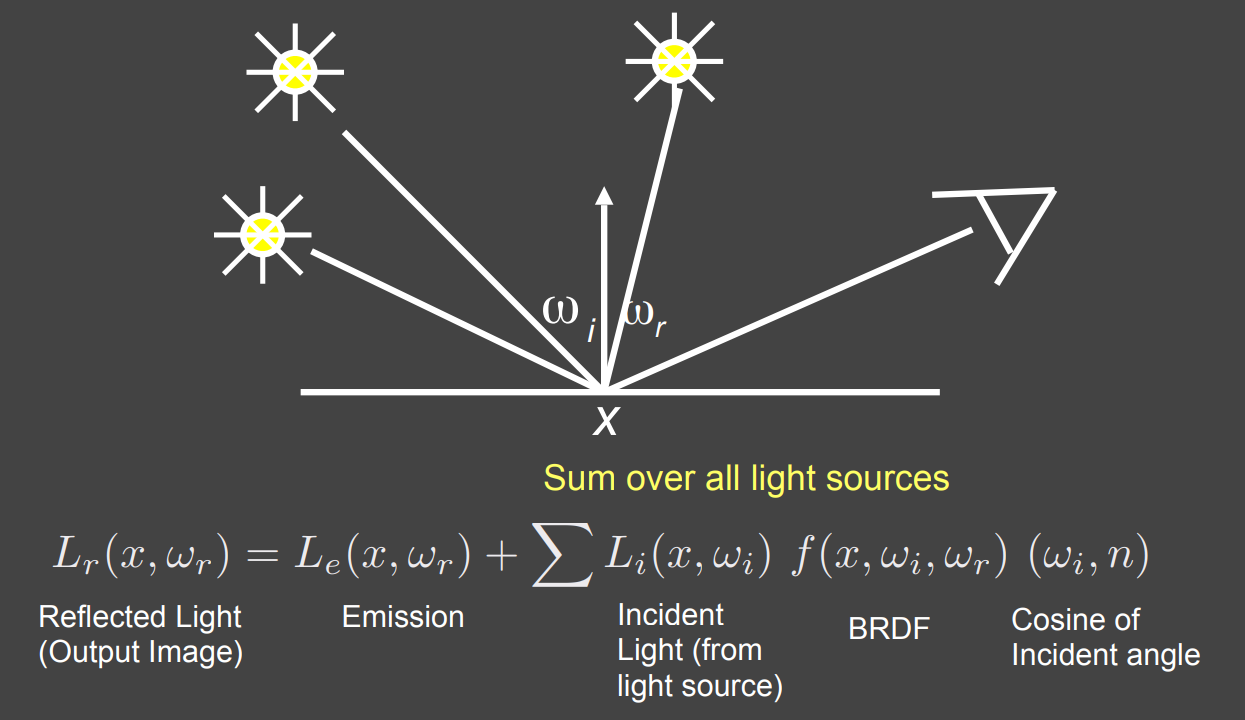
- 当有面光源时(看成点光源的集合)
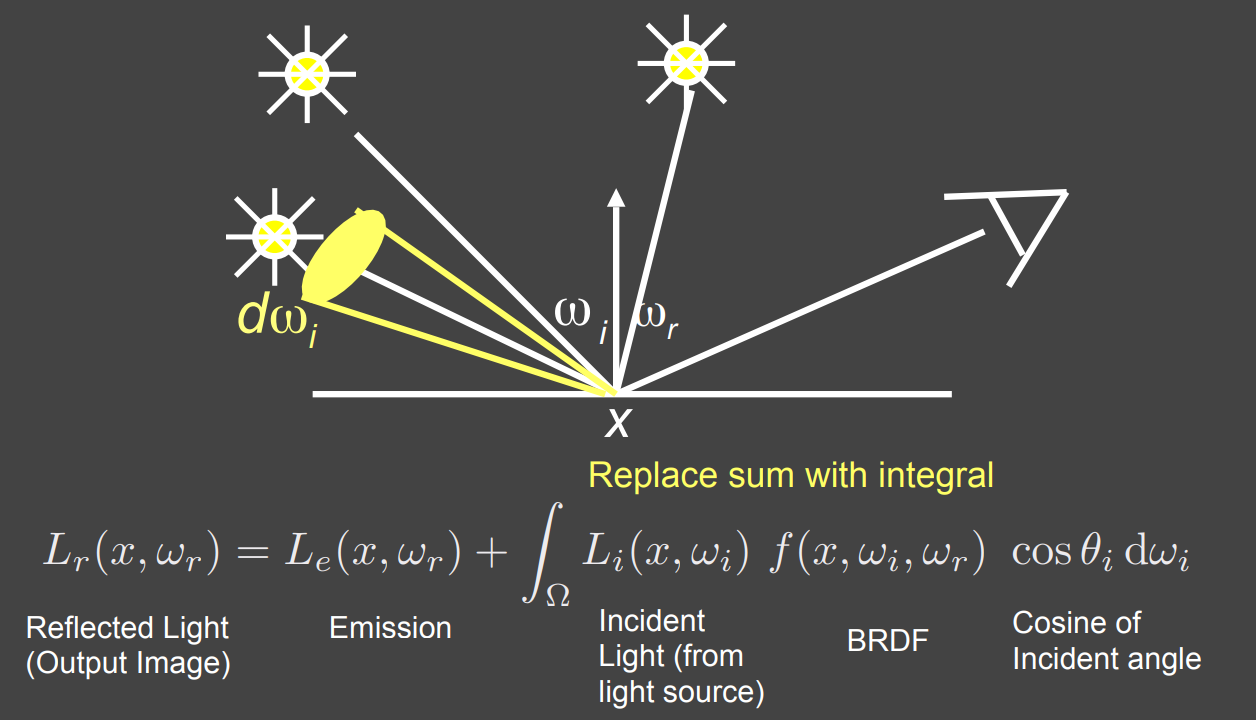
- 当有其他物体反射的 Radiance 时
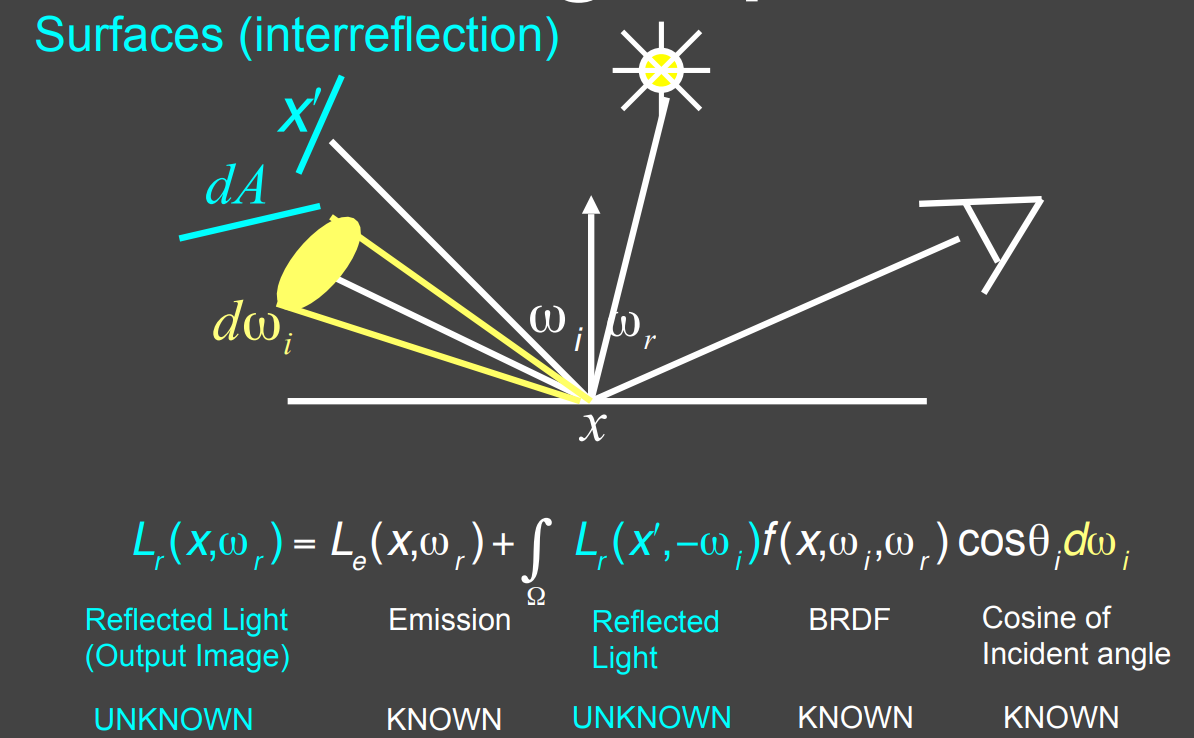
Rendering Equation as Integral Equation¶
- 对渲染方程进行简写后的结果
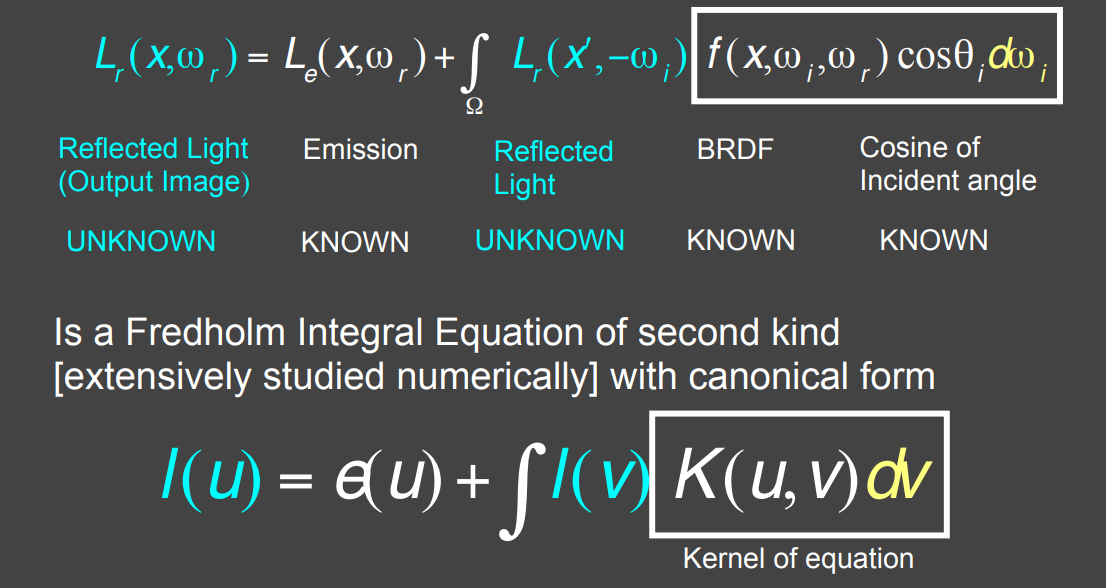
Linear Operator Equation¶
- 简化写成算子形式,目的是对渲染方程进行求解,中间省略了很多步骤
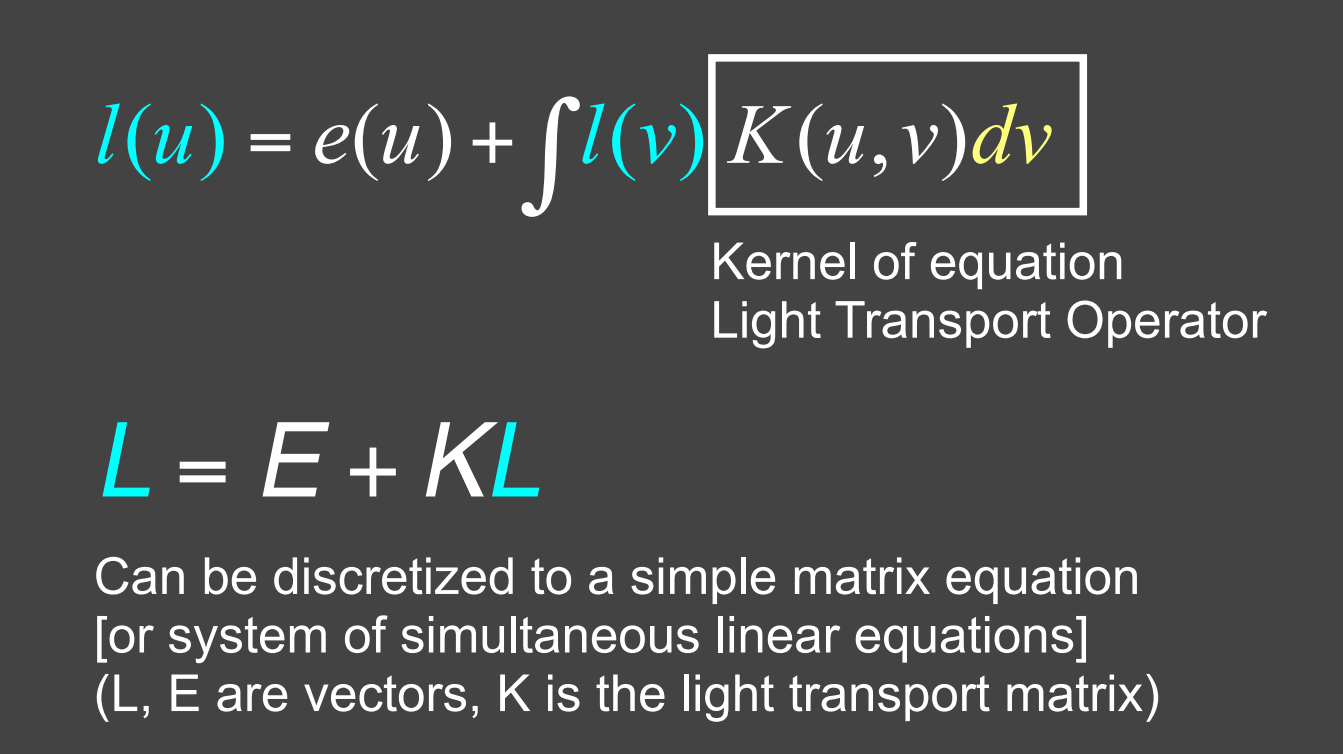
Ray Tracing and extensions¶
- General class numerical Monte Carlo methods
- Approximate set of all paths of light in scene
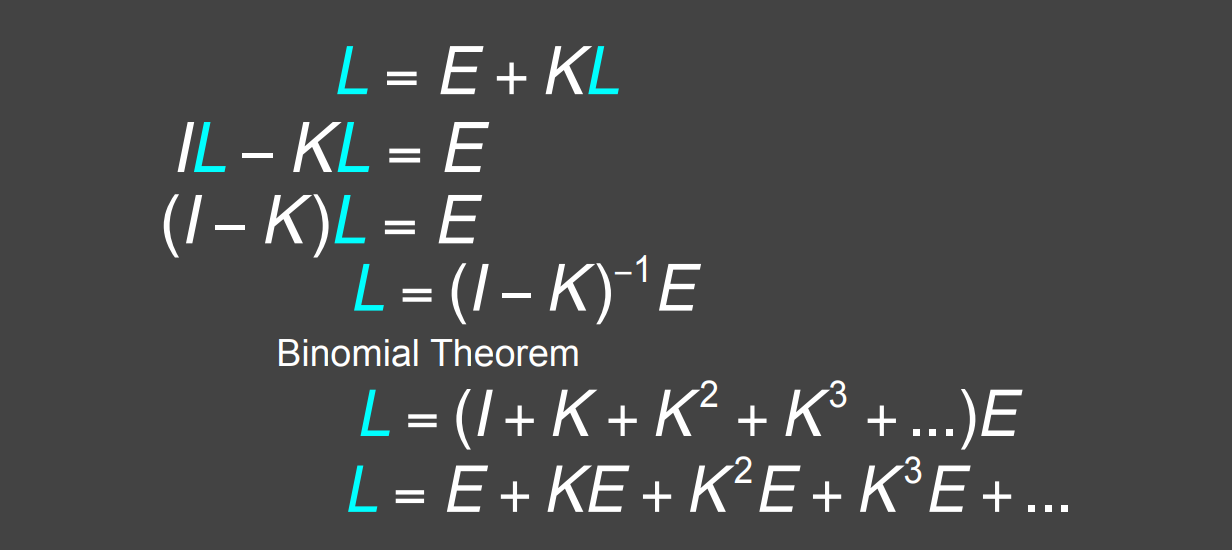
Ray Tracing¶
- 将最后看到的图写成直接看到光源、弹射一次、弹射二次....、弹射 \(n\) 次的和,结果是全局光照
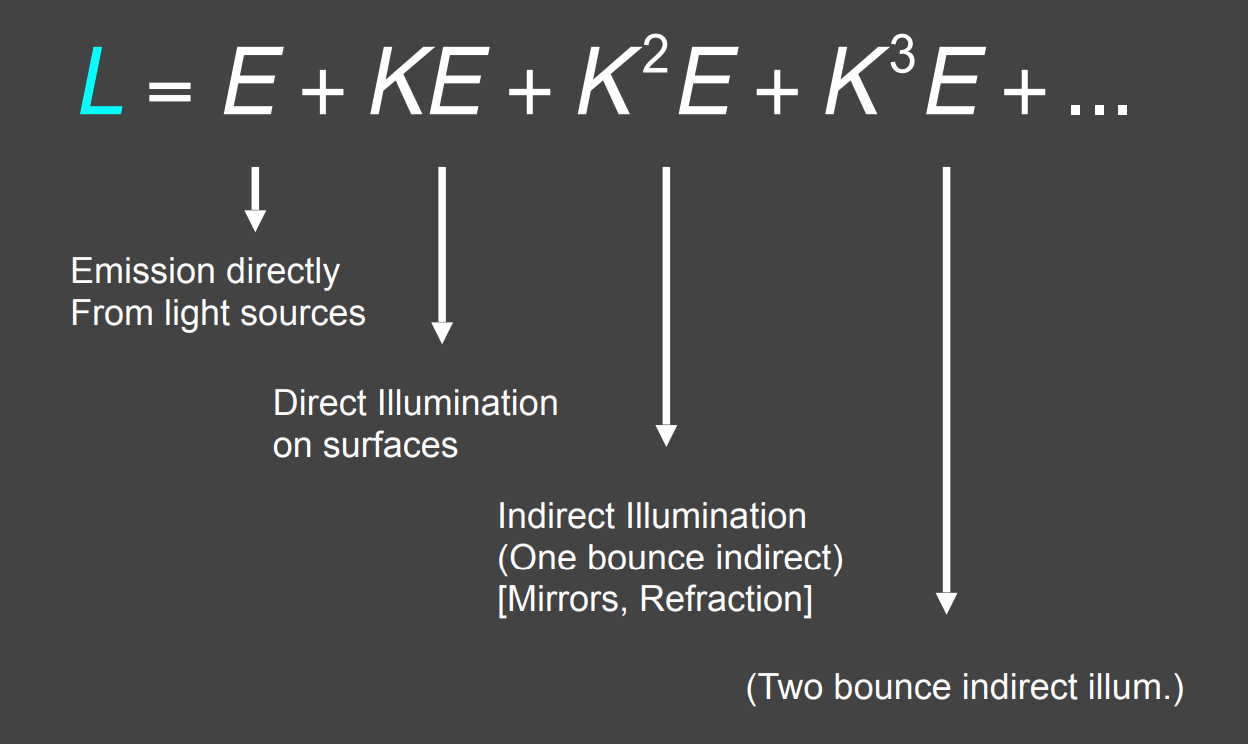
- 光栅化只解决了 \(E+KE\) 部分
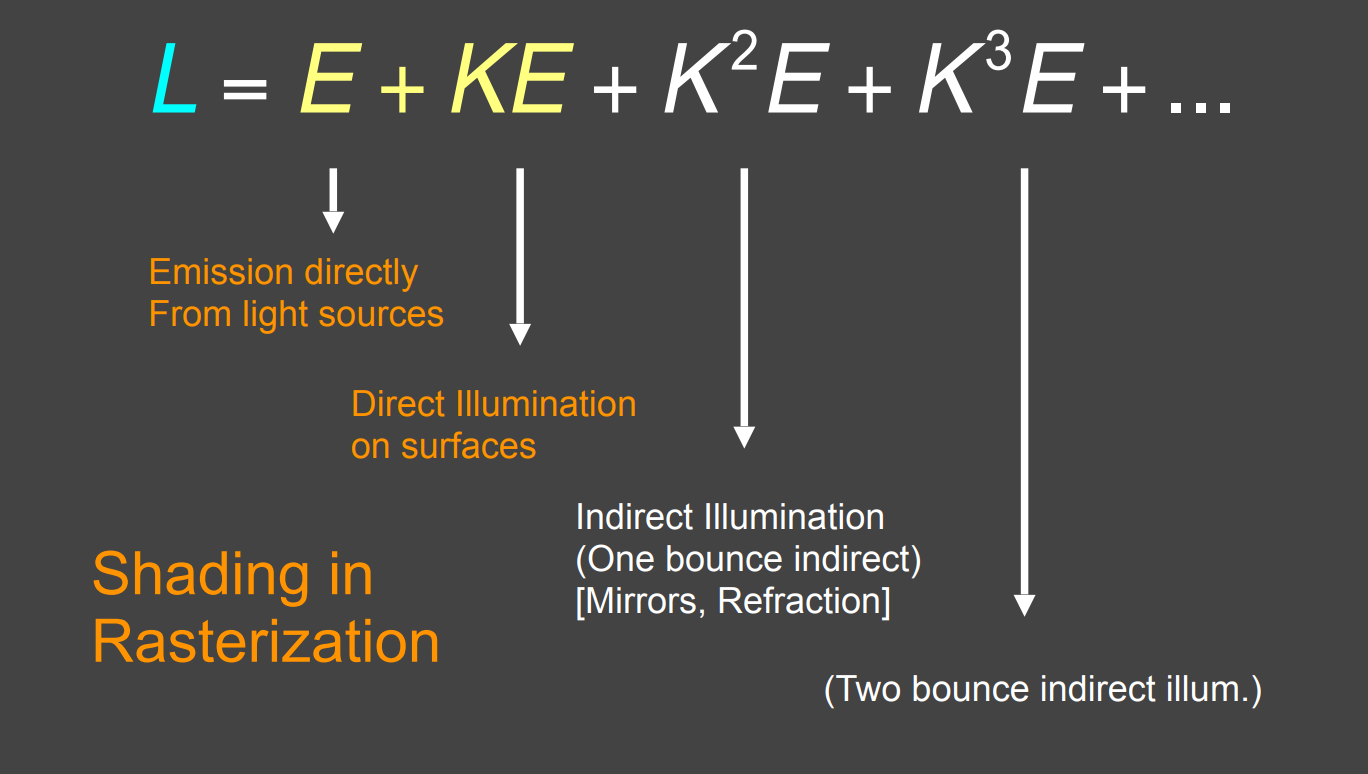
Monte Carlo Path Tracing¶
Monte Carlo Integration¶
Why&What Monte Carlo Integration¶
- 对于给定函数的定积分,直接通过解析计算求解难度太大
- Monte Carlo Integration 是一种数值方法,求出的只是一个数
- 在积分域内不断采样,假设积分区域是长方形,对于所有采样得到的结果求平均
Define Monte Carlo Integration¶
- Definite integral
- Random variable
- Monte Carlo estimator
- Note that
- The more samples, the less variance.
- Sample on \(x\), integrate on \(x\).
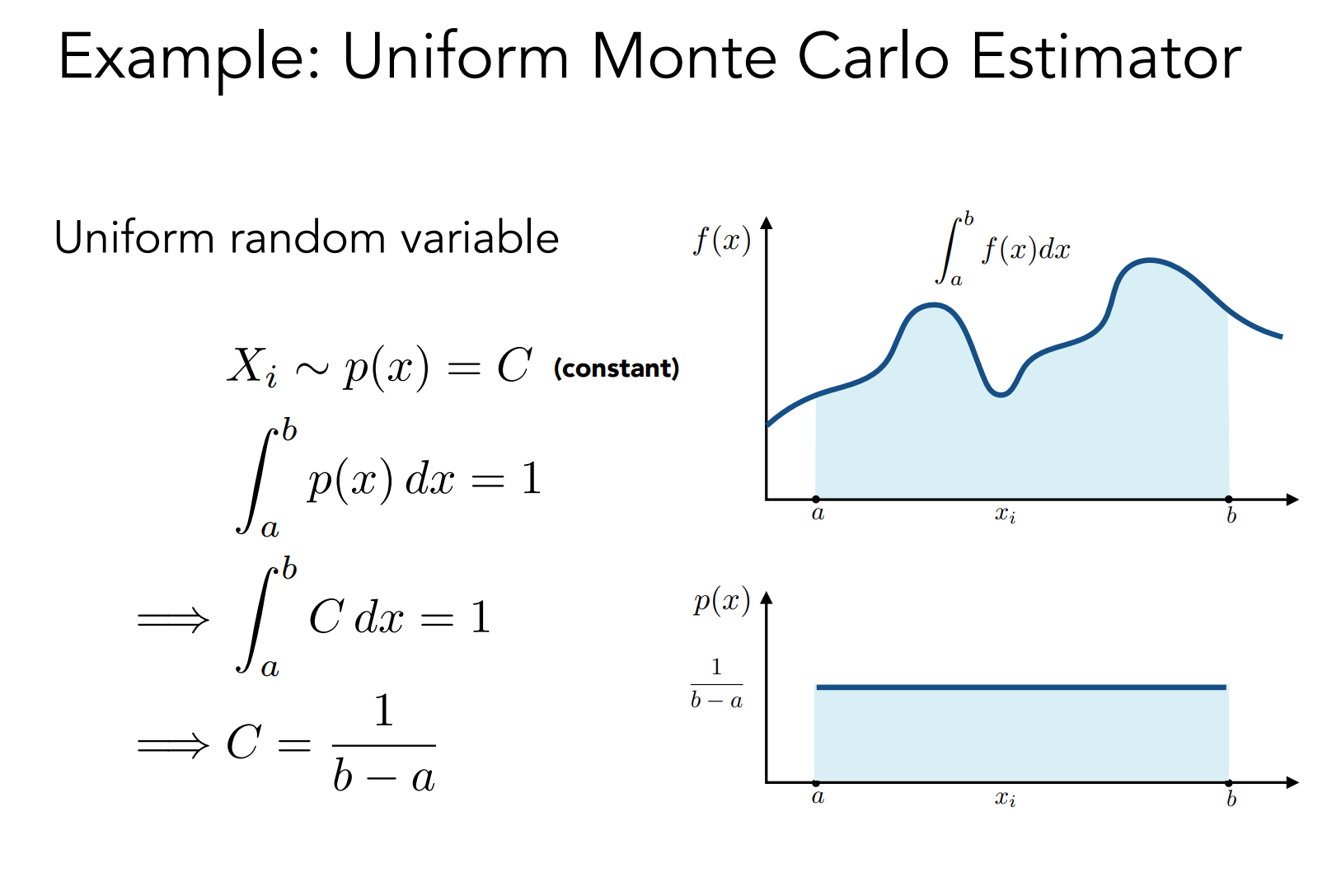
-
如果随机变量均匀采样(均匀分布),Monte Carlo Integration 有以下形式
- Definite integral
\[ \int_a^b f(x) d x \]- Uniform random variable
\(\( X_i \sim p(x)=\frac{1}{b-a} \)\)
- Basic Monte Carlo estimator
\(\( F_N=\frac{b-a}{N} \sum_{i=1}^N f\left(X_i\right) \)\)
Path Tracing¶
Motivation: Problems of Whitted-Style Ray Tracing¶
For Whitted-style ray tracing, it has some cons/ simplifications
-
Always perform specular reflections / refractions
-
Stop bouncing at diffuse surfaces
Whitted-Style Ray Tracing: Problem 1¶
- Whitted-Style Ray Tracing 对于 glossy materials 还认为光线是镜面反射的话是不对的
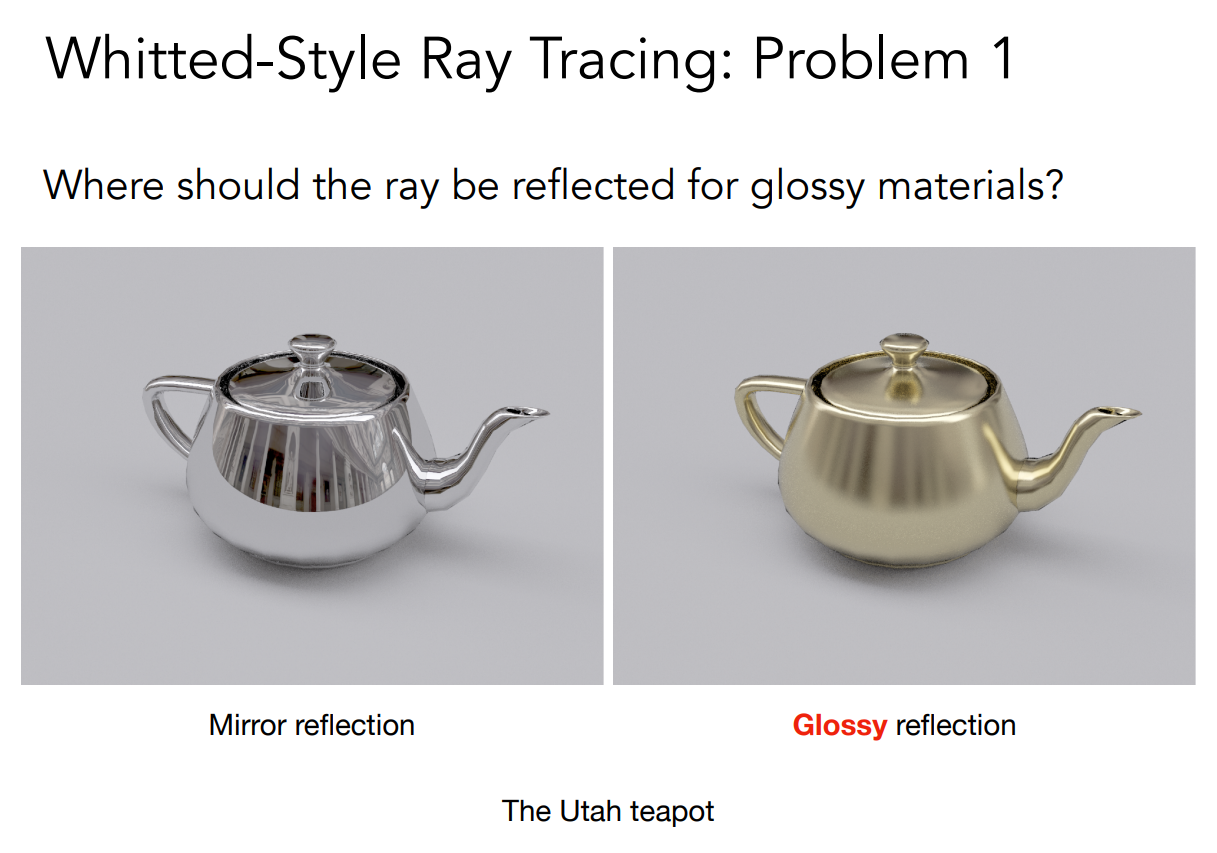
Whitted-Style Ray Tracing: Problem 2¶
- 对于 Whitted-Style Ray Tracing, No reflections between diffuse materials
- 体现在接触不到光的漫反射面反射出了接触到光的红色面的光 (color bleeding)
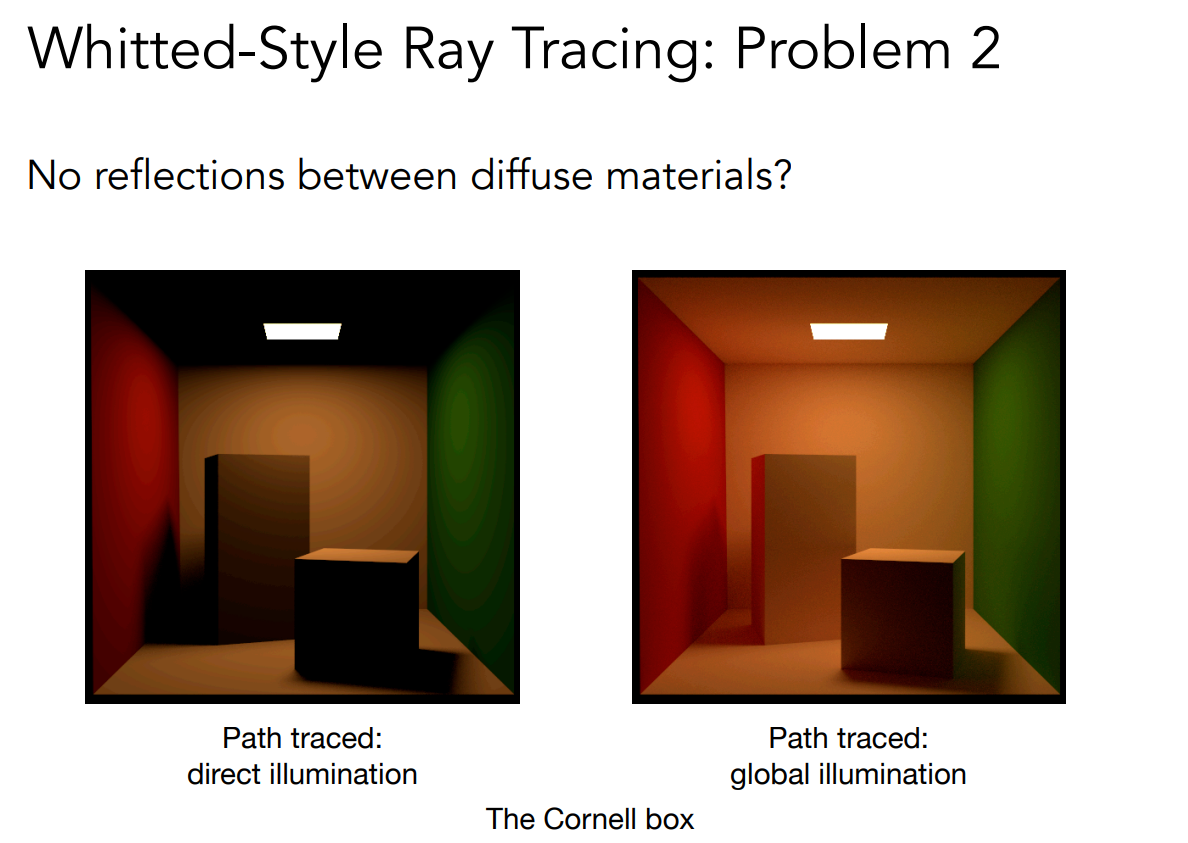
Problem Summary: Whitted-Style Ray Tracing is Wrong¶
But the rendering equation is correct
But it involves
- Solving an integral over the hemisphere, and
- Recursive execution
A Simple Monte Carlo Solution¶
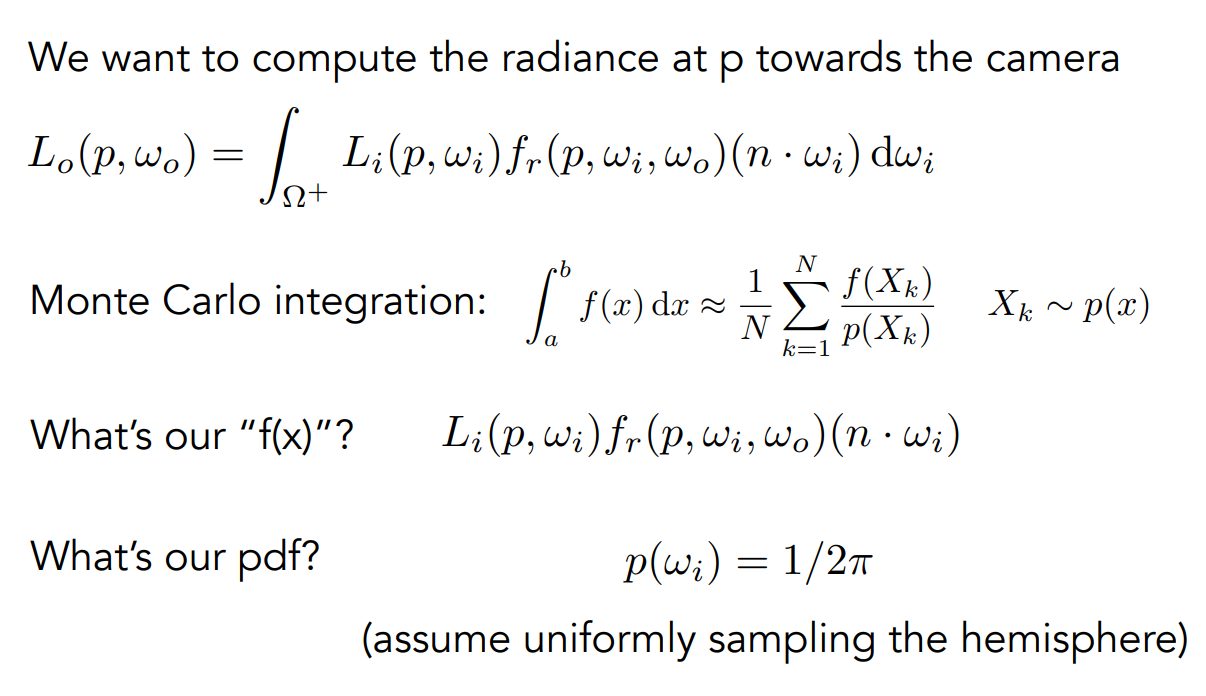
因此,对于着色点 \(p\) 的 Monte Carlo Integration 为
shade(p, wo)
Randomly choose N directions wi~pdf
Lo = 0.0
For each wi
Trace a ray r(p, wi)
If ray r hit the light
Lo += (1 / N) * L_i * f_r * cosine / pdf(wi)
Return Lo
Introducing Global Illumination¶
Naive Algorithm¶
- 考虑物体反射过来的光线,如果打到物体,就递归计算
shade(p, wo)
Randomly choose N directions wi~pdf
Lo = 0.0
For each wi
Trace a ray r(p, wi)
If ray r hit the light
Lo += (1 / N) * L_i * f_r * cosine / pdf(wi)
Else If ray r hit an object at q
Lo += (1 / N) * shade(q, -wi) * f_r * cosine / pdf(wi)
Return Lo
Problem #1: Explosion of #rays as #bounces go up - let N = 1!¶
- 光线仅仅弹射两次的话数量级就已经不可以接受了
- Key observation: #rays will not explode iff \(N = 1\)
- 当使用 \(N = 1\) 进行 Monte Carlo Integration 时 \(\to\) 路径追踪 (path tracing)
- 当使用 \(N \ne 1\) 进行 Monte Carlo Integration 时 \(\to\) 分布式光线追踪
- 使用 \(N = 1\) 进行 Monte Carlo Integration 噪声很大,但只要使用多个路径穿过一个像素对它们求平均即可
修改刚刚的算法
shade(p, wo)
Randomly choose ONE direction wi~pdf(w)
Trace a ray r(p, wi)
If ray r hit the light
Return L_i * f_r * cosine / pdf(wi)
Else If ray r hit an object at q
Return shade(q, -wi) * f_r * cosine / pdf(wi)
ray_generation(camPos, pixel)
Uniformly choose N sample positions within the pixel
pixel_radiance = 0.0
For each sample in the pixel
Shoot a ray r(camPos, cam_to_sample)
If ray r hit the scene at p
pixel_radiance += 1 / N * shade(p, sample_to_cam)
Return pixel_radiance
Problem #2: The recursive algorithm will never stop - Russian Roulette!¶
- 但是在真实世界中,光线是不会停止弹射的,限制弹射次数并不合理,因为对于弹射次数的削减相当于直接削减了能量,这违背了能量守恒定律
- Solution: Russian Roulette (RR) (俄罗斯轮盘赌)
- 在一定的概率下停止追踪,方法如下 1. 假设得到的理想追踪结果为 \(L_o\) 2. 人工设定一个概率 \(P\ (0 < P < 1)\) 3. 以概率 \(P\) shoot a ray,返回 the shading result divided by \(P: L_o/ P\) 4. 以概率 \(1-P\) shoot a ray,返回 the shading result is \(0\)
- 在这种情况下的期望 \(E= P \times (L_o / P) + (1 - P) \times 0 = L_o\)
代码如下
shade(p, wo)
Manually specify a probability P_RR
Randomly select ksi in a uniform dist. in [0, 1]
If (ksi > P_RR) return 0.0;
Randomly choose ONE direction wi~pdf(w)
Trace a ray r(p, wi)
If ray r hit the light
Return L_i * f_r * cosine / pdf(wi) / P_RR
Else If ray r hit an object at q
Return shade(q, -wi) * f_r * cosine / pdf(wi) / P_RR
Problems of Path Tracing¶
Problem #1: Not very efficient¶
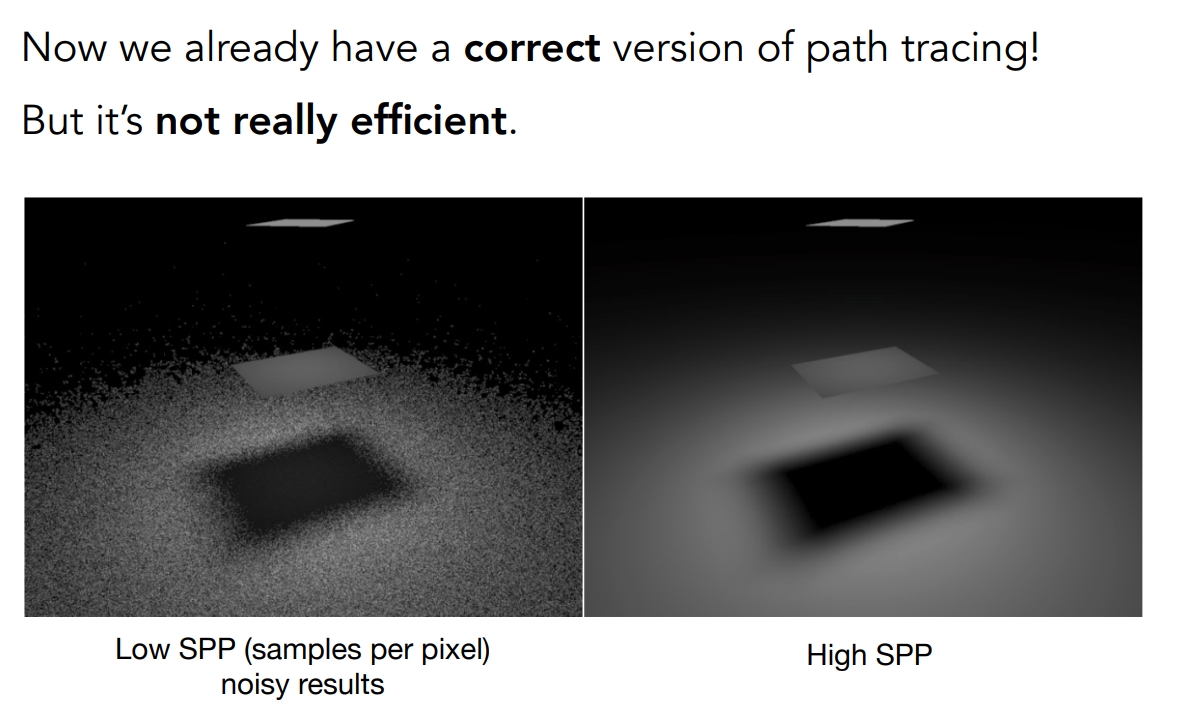
浪费现象产生的原因是我们均匀的在半球上采样,很大一部分采样没有进入光源,如果找到一个好的概率密度函数,可以提高效率 \(\to\) 直接在光源上进行采样
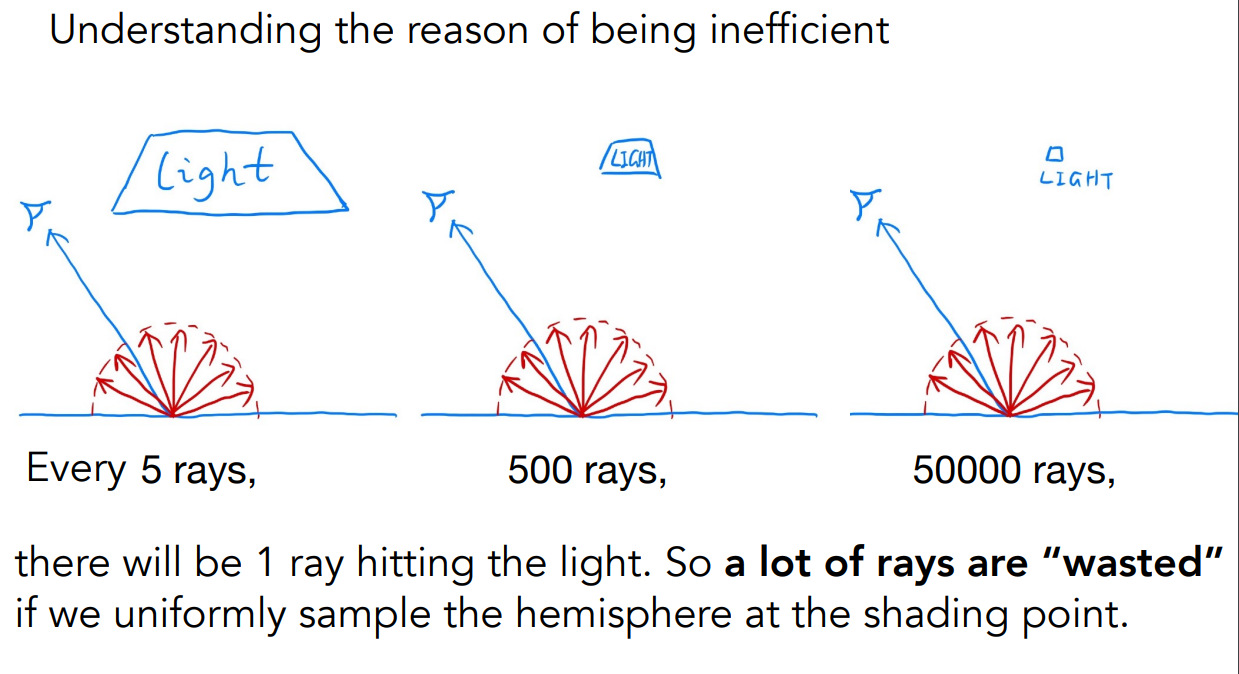
Solution #1: Sampling the Light (pure math)¶
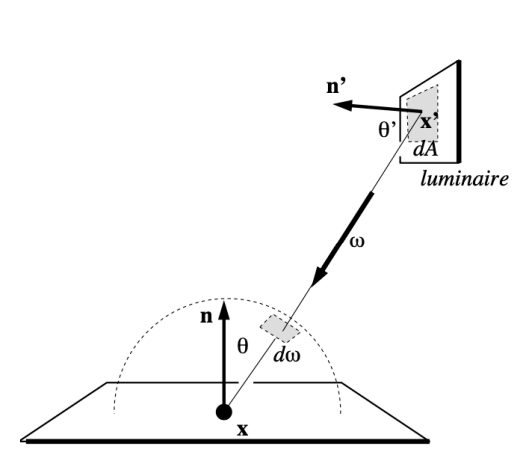
-
Assume uniformly sampling on the light: \(\text{pdf} = 1 / A\) (because \(\int \text{pdf} \ \mathrm{d}A = 1\))
-
But the rendering equation integrates on the solid angle: \(L_o = \int L_i fr cos \ \mathrm{d} \omega.\)
-
Recall Monte Carlo Integration: Sample on \(x\) & integrate on \(x\)
-
we sample on the light, so we must integrate on the light
-
我们只要知道 \(\mathrm{d} \omega\) 和 \(\mathrm{d}A\) 的关系即可
-
Recall the alternative def. of solid angle: Projected area on the unit sphere
-
将 \(\mathrm{d}A\) 往单位球上投影即可 ( \(\mathrm{d} A \cos \theta^{\prime}\) 就是把面转到朝向中心的方向,根据立体角的定义来理解下面的式子)
\[ \mathrm{d} \omega=\frac{\mathrm{d} A \cos \theta^{\prime}}{\left\|x^{\prime}-x\right\|^2} \] -
-
我们重写渲染方程即可(变量替换,改变积分域)
\(\( \begin{aligned} L_o\left(x, \omega_o\right) &=\int_{\Omega^{+}} L_i\left(x, \omega_i\right) f_r\left(x, \omega_i, \omega_o\right) \cos \theta \mathrm{d} \omega_i \\ &=\int_A L_i\left(x, \omega_i\right) f_r\left(x, \omega_i, \omega_o\right) \frac{\cos \theta \cos \theta^{\prime}}{\left\|x^{\prime}-x\right\|^2} \mathrm{~d} A \end{aligned} \)\)
Previously, we assume the light is “accidentally” shot by uniform hemisphere sampling
Now we consider the radiance coming from two parts:
- light source (colored blue, direct, no need to have RR)
- other reflectors (colored orange, indirect, RR)
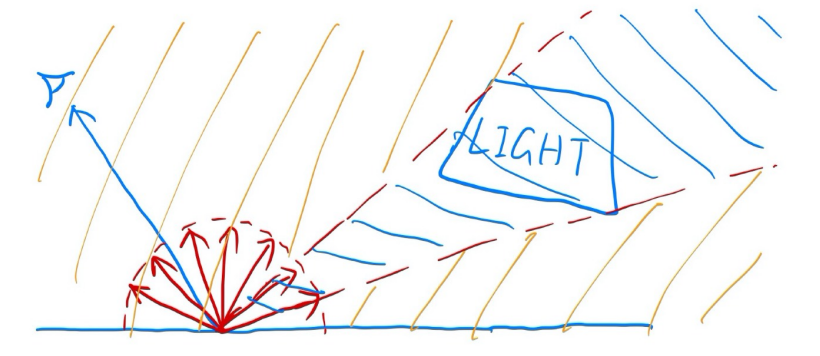
- 代码如下(拆分直接光照和间接光照)
shade(p, wo)
# Contribution from the light source.
Uniformly sample the light at x’ (pdf_light = 1 / A)
L_dir = L_i * f_r * cos θ * cos θ’ / |x’ - p|^2 / pdf_light
# Contribution from other reflectors.
L_indir = 0.0
Test Russian Roulette with probability P_RR
Uniformly sample the hemisphere toward wi (pdf_hemi = 1 / 2pi)
Trace a ray r(p, wi)
If ray r hit a non-emitting object at q
L_indir = shade(q, -wi) * f_r * cos θ / pdf_hemi / P_RR
Return L_dir + L_indir
Problem #2: Light is not blocked or not¶
- 在之前的计算中,假设了光线不会被挡到
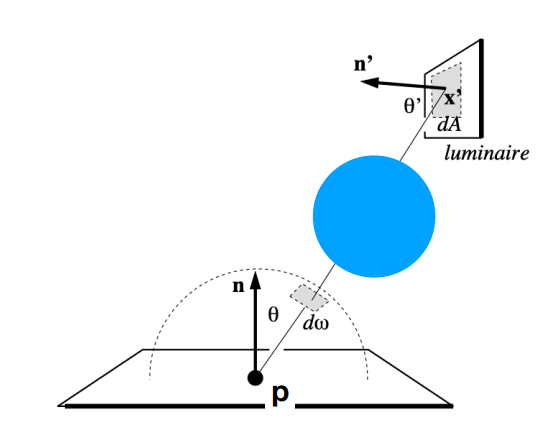
Solution #2: Give a ray from P¶
- 考虑点 \(p\) 到 \(x'\) 的连线,从 \(p\) 点打一根光线,看看有没有被挡到
# Contribution from the light source.
L_dir = 0.0
Uniformly sample the light at x’ (pdf_light = 1 / A)
Shoot a ray from p to x’
If the ray is not blocked in the middle
L_dir = …
Some Side Notes¶
-
Previous
- Ray tracing == Whitted-style ray tracing
-
Modern (my own definition)
- The general solution of light transport, including
- (Unidirectional & bidirectional) path tracing
- Photon mapping
- Metropolis light transport - VCM / UPBP…
- Uniformly sampling the hemisphere
- How? And in general, how to sample any function? (sampling)
- Monte Carlo integration allows arbitrary pdfs
- What's the best choice? (importance sampling)
- 重要性采样:针对某一种特定形状进行采样
- Do random numbers matter?
- Yes! (low discrepancy sequences)
- I can sample the hemisphere and the light
- Can I combine them? Yes! (multiple imp. sampling)
- 结合从半球和光源的采样方法
- The radiance of a pixel is the average of radiance on all paths passing through it
- Why? (pixel reconstruction filter)
- Is the radiance of a pixel the color of a pixel?
- No. (gamma correction, curves, color space)
Importance Sampling¶
- 让 PDF 正比于部分的被积函数
https://zhuanlan.zhihu.com/p/360420413
Created: June 16, 2023